Internet of Spacecraft for Multi-Planetary Defense and Prosperity
Abstract
:1. Introduction
- A comprehensive review of spacecraft projects, astronomical research, space exploration missions of critical milestones in human history is introduced and reviewed.
- A thorough review, investigation, and analysis of the outer-space threats, planetary defense, and space colonization are presented. The theories and scientific findings of the origins of asteroids and comets plus the technologies of detection and mitigation of potentially hazardous objects are investigated and analyzed.
- A novel framework named the Solar Communication and Defense Networks (SCADN) is proposed. It consists of a large number of distributed spacecraft/spaceships which are capable of enabling the Internet of distributed deep-space sensing, communications, and defense. An in-depth analysis is conducted to analyze how SCADN can increase the success rate of early detection of asteroids/comets/objects jeopardizing the safety of Earth and other colonized planets/moons. Furthermore, the SCADN-based mitigation strategies of preventing outer-space objects triggered extinction events are also presented and discussed.
- Last but not least, to better serve the common interest of all mankind, several legal matters and legislative concerns about founding the SCADN framework have been presented and discussed.
2. Extra-Terrestrialization: Make Life Multi-Planetary
2.1. Space Transportation
2.2. An Interplanetary Spacecraft Design Example: Starship
2.3. Foundation on Another Celestial Body
2.4. Terraforming
3. Space Threats and Planetary Defense History
3.1. Serious Threats from Outer Space
3.1.1. Cretaceous–Paleogene Extinction
3.1.2. Other Significant Events
3.2. Planetary Defense: When and How It Started
3.2.1. Timeline
3.2.2. Organization and Projects
4. Planetary Defense: State-of-the-Art
4.1. Origins of Asteroids and Comets
4.1.1. The Main Asteroid Belt
4.1.2. The Kuiper Belt
4.2. Potentially Hazardous Objects and Detection
4.3. State of the Art Space Objects Detection
4.3.1. Detection Capability According to Object Dimension
4.3.2. Detection and Early Warning
4.3.3. On-Ground Observatories
5. Multi-Planetary Detection, Communications, and Defense: Live Long and Prosper
- First, due to many types of random events and their consequences, asteroids and comets can escape or change their former orbits and enter the near-Earth space, which increases the probability of their impact with Earth. The current asteroids/comets detection is focused on the NEO category, which may limit the preparation time allowed for humanity. Although more than 96% of total estimated large asteroids (with a diameter of 1 km and more) in the near-Earth space have been surveyed so far, the proportion of NEAs (with a diameter between 100 m and 1000 m) is still very low.
- Second, the detection capability of on-ground telescopes highly depends on their geological and meteorological conditions. Only several specific locations on Earth can fulfill such challenging requirements for high-quality observation. Moreover, most on-ground observatories operate in visible light and radio frequencies. Just a few ground-based telescopes work in infrared wavelengths, and many infrared telescopes are space-based to minimize the Earth’s interference and background noise.
- Third, the ground-based observatories are usually powerful with abundant facilities and local technical support, while space-based ones normally depend only on the solar array and remote debugging. On the other hand, space-based telescopes have obvious advantages over the on-ground ones to survey the sky in infrared wavelengths, thus playing a crucial role in identifying and locating NEOs. For example, most asteroids are black, and small ones are difficult to see in the blackness of outer space with an optical telescope. Still, a telescope operating at infrared wavelengths is sensitive to asteroids’ surfaces warmed by the Sun.
5.1. Evolving the Networks of Survey Stations
- A large number of survey stations (on spacecraft) will be deployed into various orbits across the entire solar system to form an enormous Internet of spacecraft (IoS) networks. As humans are supposed to become a multi-planetary species after extra-terrestrialization, the colonization of other celestial bodies could also fall victim to asteroid/comets impact. For example, due to the lack of a thick atmosphere as on Earth, Mars could be more vulnerable to the impact of near-Mars objects (NMO). Moreover, Jupiter and Saturn, the gas giants which are 318 times and 95 times as massive as Earth, can affect and steer some asteroids away from Earth, thus providing some protection to humanity. However, Jupiter and Saturn attract asteroids/comets to their regions and increase the impact probability on their moons including Europa [151], Titan [152], and Enceladus [15] which are particularly interesting and may be possible sites for human colonization. Similarly, some moons of ice giants Uranus and Neptune also can serve as humanity’s colonization and outpost for even further expeditions in the universe. Consequently, deploying survey stations and spacecraft into regions/orbits of Mars, Jupiter, Saturn, Uranus, and Neptune is also crucial.
- As illustrated in Figure 17, for each planet in the solar system, multiple survey stations/spacecraft are deployed in the planet’s orbit. In the SCADN, the specific locations for accommodating these spacecraft can be on Lagrange points where the gravitational forces of the two large bodies and the centrifugal force balance each other so that spacecraft only require minimal orbital corrections. Take Earth for example; multiple survey stations/spacecraft can be deployed on Earth–Sun Lagrange points, L2, S-E, L3, S-E, L4, S-E, and L5, S-E, respectively. There are several features enabled by adopting such a strategy. First, L2, S-E, which has a distance of around 0.01 AU from Earth, can enable a high-performance survey (with minimal interference from the Sun) to the space in the direction away from the Sun but a reliable communication with Earth. Second, L3, S-E, L4, S-E, and L5, S-E can help survey space more thoroughly and completely than on/near-Earth stations. For instance, the object within a specific elongation from the Sun, which is a region of the sky giving no access to ground-based telescopes, will be discovered by stations deployed in these locations. Therefore, the probability of failed detection and the absence of alarms of incoming objects from outer space (such as the Chelyabinsk meteorite) will be minimized.
- Furthermore, as shown in the exemplary illustration, the Lagrange points of other planets such as Venus, Mars, Jupiter, and Saturn, will also be deployed with survey stations/spacecraft. For example, Venus has an average distance of 0.72 AU from the Sun and orbits the Sun faster than other outer planets. Therefore, deploying survey stations/spacecraft into the four Lagrange points of Venus can also help survey the potentially hazardous objects approaching other outer planets (of Venus) more effectively. Since the space increases over the growth of orbits, deploying more survey stations/spacecraft for planets of interest using this method will cover more space and further minimize the failure detection and warning. It is noteworthy that Figure 17 is just such an exemplary case of many; Mercury, Uranus, and Neptune are not shown for simplicity. All survey stations and spacecraft are inter-connected and can collaborate on a series of survey tasks to realize a better overall performance gain. On each Lagrange point, there may be more than one survey station/spacecraft needed to fulfill the specific requirement. Eventually, a very large sphere of at least more than 30 AU in the radius can be covered under the SCADN so that many more space objects that previously could not be located/tracked by humans could be fully available in the database. Moreover, these survey stations/spacecraft could serve for other space exploration and scientific experiment tasks, thanks to their unique celestial coordinates.
- All survey stations and spacecraft are expected to communicate and connect with each other using multiple state-of-the-art communications and networking technologies. Some of the unprecedented challenges for wireless communications are the very long distances over which the wireless signals need to travel and the solar flares that can seriously interrupt the radio communication. In addition, the meteorological conditions on Earth and other celestial bodies can lead to degradation in wireless communications. Although the low data rate communication over very long distances in deep space is proven to be working well (such as Voyager 1 and 2 that are currently around 155.6 AU and 129.9 AU from the Sun), a high data rate can still be challenging even today. Another challenge is the significant latency. With 1 AU distance meaning 499 s for light to travel in free space, the distance between Saturn’s L3, S-S and Saturn itself is 19 AU or 9481 s (around 158 min) for light to fly. The communication latency between Neptune and its L3, S-N is around 500 min. Moreover, the latency between Earth and Lagrange points of different planets varies over time.
- Considering the challenges of wireless communications over extremely long propagation, particularly the very large latency, using Earth as the only routing point to store, exchange, and process data and telemetry commands from survey stations/spacecraft may lead to a very long latency and low efficiency. There are several potential solutions to this dilemma. For example, it would be beneficial to enable artificial intelligence (AI) and edge computing on the survey stations/spacecraft so that they could process the image and data extracted from space and determine if any detection falls into interest or any further resource (other survey stations/spacecraft and computing power) is needed to assist in the task. Moreover, any communication interruption due to interference could be mitigated when using some of the available survey stations/spacecraft as relays. Eventually, such an AI and edge computing assisted, cell-free architect can improve the overall system efficiency of wireless communications in deep space and identify the objects of interest.
- Such a multi-task capable SCADN framework can facilitate more interesting space exploration missions and astronomical research. For example, the survey stations within the framework can be used to search for and observe exoplanets and black holes. The spacecraft/spaceships can even be dispatched to investigate any space object of interest in their vicinity so that some mysterious or strange objects (e.g., ’Oumuamua) and their origins could be better understood.
5.2. Equipping the SCADN with Mitigation Technologies
- Ideally, a hybrid of PHO deflection schemes can be deployed to the spacecraft in each planet’s Lagrange points. For example, in remote areas such as around Saturn, Uranus, or Neptune, the low-cost and slow-paced schemes (non-nuclear scheme) can work over an allowable time window that is usually large enough. For example, whenever a space object is detected and determined to be a threat to Earth or other humans’ colonization by the SCADN, one or more spacecraft patrolling in the nearest proximity or being able to intercept the PHO on its collision course will be scheduled and coordinated to handle the mitigation.
- If the situation is so urgent that a fast response is needed immediately, the decision making, resource allocation, task scheduling, and trajectory planning can be fully autonomous, e.g., completely directed by AI/edge-computing, to overcome the large latency in space communication (due to the extremely large space travel distance). The early detection and mitigation will result in lower cost and a higher success rate of mitigation. The power supply can be a hybrid source of nuclear battery and solar panel, while the propulsive devices can be of various types, e.g., cold gas thruster, electrohydrodynamic thruster, electrodeless plasma thruster, electrostatic ion thruster, Hall effect thruster, magnetoplasmadynamic thruster, etc.
- An illustrative description of an exemplary application scenario is presented in Figure 19a, where a space object is detected and identified as having a high probability of impacting Earth within less than one year. The SCADN framework calculates its trajectory (in the red dash line), determines its mass and characteristics, and makes feasible mitigation strategies and plans. Eventually, the SCADN schedules the available spacecraft equipped with suitable mitigation technologies to intercept the object. During this procedure, the spacecraft perhaps need to change its orbit, accelerate or decelerate, which can lead to the consumption of power and thrust on board the spacecraft. In case one spacecraft fails a mitigation task, SCADN can call for multiple spacecraft simultaneously from different orbital locations of different planets to perform the interception.
- The SCADN framework is capable of computing and mobilizing all available resources within its framework to monitor any space object sensed, estimate the risk, and take the corresponding actions. Such a SCADN framework is supposed to be robust enough that it can still be functional to detect and mitigate the risk even when some spacecraft/survey stations within the framework cannot work properly or human operators are not available. A brief flow chart of the SCADN is given in Figure 19b, where the SCADN framework will utilize all available spacecraft to perform the interception until the impact risk is completely neutralized. Since all spacecraft being able to conduct the mitigation missions are continuously on alert in space, the success rate is largely improved compared to any improvisational interception launch mission from Earth.
5.3. Long-Term Universal Efforts
6. Conclusions
7. Future Research Directions
- The trajectory and orbital plans need to be designed and verified to estimate the technological feasibility, expense of resources, the time of development, and deployment.
- The PHOs mitigation technologies need to be well investigated and developed, particularly for the feasible clean type compatible with international treaties.
- The AI and edge-computing-aided wireless communications and networking technologies for deep-space sensing and communications need to be thoroughly investigated.
Funding
Institutional Review Board Statement
Informed Consent Statement
Data Availability Statement
Acknowledgments
Conflicts of Interest
References
- Armstrong, N. Buzz Aldrin Removing the Passive Seismometer from a Compartment in the SEQ Bay of the Lunar Lander. 21 July 1969. Available online: https://en.wikipedia.org/wiki/File:Apollo_11_Lunar_Lander_-_5927_NASA.jpg (accessed on 8 May 2022).
- NASA. The SpaceX Crew Dragon Spacecraft, with Its Nose Cone Open, is Pictured Docked to the Harmony Module’s forward International Docking Adapter. Available online: https://images.nasa.gov/details-iss064e027440 (accessed on 8 May 2022).
- NASA/Crew-2. The International Space Station is Pictured from the SpaceX Crew Dragon Endeavour during a Flyaround of the Orbiting Lab that Took Place Following Its Undocking from the Harmony Module’s Space-Facing Port on 8 November 2021. 8 November 2021. Available online: https://commons.wikimedia.org/wiki/File:View_of_the_ISS_taken_during_Crew-2_flyaround_(ISS066-E-081311).jpg (accessed on 8 May 2022).
- NASA. The Hubble Space Telescope (HST) Begins Its Separation from Space Shuttle Discovery Following Its Release on Mission STS-82. 1997. Available online: https://apod.nasa.gov/apod/ap021124.html (accessed on 8 May 2022).
- NASA/JPL. PIA03883: Artists’s Conception of Cassini Saturn Orbit Insertion. 2002. Available online: https://photojournal.jpl.nasa.gov/catalog/PIA03883 (accessed on 8 May 2022).
- European Space Agency. Rosetta and Philae at Comet: Artist’s Impression of the Rosetta Orbiter Deploying the Philae Lander to Comet 67P/Churyumov–Gerasimenko. 2013. Available online: https://www.flickr.com/photos/europeanspaceagency/11206660686/ (accessed on 8 May 2022).
- Adams, E.; O’Shaughnessy, D.; Reinhart, M.; John, J.; Congdon, E.; Gallagher, D.; Abel, E.; Atchison, J.; Fletcher, Z.; Chen, M.; et al. Double Asteroid Redirection Test: The Earth Strikes Back. In Proceedings of the IEEE Aerospace Conference, Big Sky, MT, USA, 2–9 March 2019; pp. 1–11. [Google Scholar] [CrossRef]
- Ackerman, E. SpaceX Planning to Land Autonomous Reusable Rockets on Drone Ships. Available online: https://spectrum.ieee.org/spacex-planning-to-land-autonomous-reusable-rockets-on-drone-ships-next-month (accessed on 8 May 2022).
- Krahn, J. Starship SN9 Sitting on Its Launch Pad in Starbase. Available online: https://commons.wikimedia.org/wiki/File:Starship_SN9_Launch_Pad.jpg (accessed on 8 May 2022).
- Seife, C. Dark energy tiptoes toward the spotlight. Science 2003, 300, 1896–1897. [Google Scholar] [CrossRef] [PubMed]
- Brumfiel, G. How they wonder what you are. Nature 2008. [Google Scholar] [CrossRef]
- Reichhardt, T. Is the next big thing too big? Nature 2006, 440, 140–143. [Google Scholar] [CrossRef]
- Billings, L. Space science: The telescope that ate astronomy. Nature 2010, 467, 1028–1030. [Google Scholar] [CrossRef] [PubMed]
- NASA/Goddard Space Flight Center/Pat Izzo. The Full-Scale Model is Assembled on the Lawn at Goddard Space Flight Center, and Displayed during 19–25 September 2005. 2005. Available online: https://www.jwst.nasa.gov/images/people.jpg (accessed on 8 May 2022).
- Hansen, C.J.; Esposito, L.; Stewart, A.I.F.; Colwell, J.; Hendrix, A.; Pryor, W.; Shemansky, D.; West, R. Enceladus’ water vapor plume. Science 2008, 311, 1422–1425. [Google Scholar] [CrossRef] [PubMed] [Green Version]
- Hansen, C.J.; Esposito, L.W.; Stewart, A.I.F.; Meinke, B.; Wallis, B.; Colwell, J.E.; Hendrix, A.R.; Larsen, K.; Pryor, W.; Tian, F. Water vapour jets inside the plume of gas leaving Enceladus. Nature 2008, 456, 477–479. [Google Scholar] [CrossRef] [PubMed]
- Bertotti, B.; Iess, L.; Tortora, P. A test of general relativity using radio links with the Cassini spacecraft. Nature 2003, 425, 374–376. [Google Scholar] [CrossRef] [PubMed]
- Butler, D. Spiralling costs dog comet mission. Nature 2003, 423, 372–373. [Google Scholar] [CrossRef]
- Gibney, E. Historic Rosetta mission to end with crash into comet. Nature 2015, 527, 16–17. [Google Scholar] [CrossRef] [Green Version]
- Gibney, E. Mission accomplished: Rosetta crashes into comet. Nature 2016, 538, 13–14. [Google Scholar] [CrossRef] [Green Version]
- Vernazza, P.; Ferrais, M.; Jorda, L.; Hanuš, J.; Carry, B.; Marsset, M.; Brož, M.; Fetick, R.; Viikinkoski, M.; Marchis, F.; et al. VLT/SPHERE imaging survey of the largest main-belt asteroids: Final results and synthesis. Astron. Astrophys. 2021, 654, A56. [Google Scholar] [CrossRef]
- Elkins-Tanton, L.T.; Asphaug, E.; Bell, J.; Bercovici, D.; Bills, B.G.; Binzel, R.P.; Bottke, W.F.; Jun, I.; Marchi, S.; Oh, D.; et al. Journey to a metal world: Concept for a Discovery Mission to Psyche. In Proceedings of the 45th Lunar and Planetary Science Conference, The Woodlands, TX, USA, 17–21 March 2014. [Google Scholar]
- Shear, W. The early development of terrestrial ecosystems. Nature 1991, 351, 283–289. [Google Scholar] [CrossRef]
- Garwood, R.J.; Edgecombe, G.D. Early terrestrial animals, evolution, and uncertainty. Evol. Educ. Outreach 2011, 4, 489–501. [Google Scholar] [CrossRef] [Green Version]
- MacIver, M.; Schmitz, L.; Mugan, U.; Murphey, T.; Mobley, C. Massive increase in visual range preceded the origin of terrestrial vertebrates. Proc. Natl. Acad. Sci. USA 2017, 114, E2375–E2384. [Google Scholar] [CrossRef] [Green Version]
- Musk, E. Making humans a multi-planetary species. New Space 2017, 5, 46–61. [Google Scholar] [CrossRef]
- Musk, E. Making life multi-planetary. New Space 2018, 6, 2–11. [Google Scholar] [CrossRef]
- Musk, E. Risky Business. IEEE Spectr. 2009, 46, 40–41. [Google Scholar] [CrossRef]
- Jones, H.W. The recent large reduction in space launch cost. In Proceedings of the 48th International Conference on Environmental Systems, New Mexico, FL, USA, 8–12 July 2018. [Google Scholar]
- Koelle, D.E. TRANSCOST, Statistical-Analytical Model for Cost Estimation and Economic Optimization of Space. Transportation Systems; MBB Report; URV-185; Raumtransportsysteme und Antriebe, Deutsche Aerospace: Köln, Germany, 1991. [Google Scholar]
- NASA. Advanced Space Transportation Program: Paving the Highway to Space. Available online: https://www.nasa.gov/centers/marshall/news/6 (accessed on 8 May 2022).
- SpaceX. Starship Users Guide. Revision1. 2020. Available online: https://www.spacex.com/starship/7 (accessed on 8 May 2022).
- Mann, A. SpaceX Now Dominates Rocket Flight, Bringing Big Benefits and Risks to NASA. Available online: https://www.science.org/content/article/spacex-now-dominates-rocket-flight-bringing-big-benefits-and-risks-nasa (accessed on 20 May 2022).
- Georgina, T. SpaceX’s Hexagon Heat Shield Tiles Take on an Industrial Flamethrower. Digital Trends. 2019. Available online: https://www.digitaltrends.com/cool-tech/spacex-hexagon-heat-shield-tiles/ (accessed on 8 May 2022).
- McKay, C.; Toon, O.; Kasting, J. Making Mars habitable. Nature 1991, 352, 489–496. [Google Scholar] [CrossRef]
- Kasting, J. Warming early Earth and Mars. Science 1997, 276, 1213. [Google Scholar] [CrossRef]
- Tosca, N.J.; Knoll, A.H.; McLennan, S.M. Water activity and the challenge for life on early Mars. Science 2008, 320, 1204–1207. [Google Scholar] [CrossRef]
- McEwen, A.S.; Ojha, L.; Dundas, C.M.; Mattson, S.S.; Byrne, S.; Wray, J.J.; Cull, S.C.; Murchie, S.L.; Thomas, N.; Gulick, V.C. Seasonal flows on warm Martian slopes. Science 2011, 333, 740–743. [Google Scholar] [CrossRef] [PubMed] [Green Version]
- JPL. Seasonal Changes in Mars’ North Polar Ice Cap. 1998. Available online: https://www.jpl.nasa.gov/images/pia01247-seasonal-changes-in-mars-north-polar-ice-cap (accessed on 8 May 2022).
- Sanders, G. Mars ISRU: State-of-the-Art and System Level Considerations. 2016. Available online: Http://kiss.caltech.edu/workshops/isru/presentations/Sanders.pdf (accessed on 8 May 2022).
- Rönsch, S.; Schneider, J.; Matthischke, S.; Schlüter, M.; Götz, M.; Lefebvre, J.; Prabhakaran, P.; Bajohr, S. Review on methanation—From fundamentals to current projects. Fuel 2015, 166, 276–296. [Google Scholar] [CrossRef]
- Gibney, E. How to build a Moon base. Nature 2018, 562, 474–478. [Google Scholar] [CrossRef] [PubMed] [Green Version]
- Hepp, A.F.; Linne, D.L.; Landis, G.A.; Wadel, M.F.; Colvin, J.E. Production and use of metals and oxygen for lunar propulsion. J. Propuls. Power 1994, 10, 834–840. [Google Scholar] [CrossRef] [Green Version]
- Wittenberg, L.J.; Cameron, E.N.; Kulcinski, G.L.; Ott, S.H.; Santarius, J.F.; Sviatoslavsky, G.I.; Sviatoslavsky, I.N.; Thompson, H.E. A Review of 3He Resources and Acquisition for Use as Fusion Fuel. Fusion Technol. 1992, 21, 2230–2253. [Google Scholar] [CrossRef]
- NASA. Moon to Mars Overview. Available online: https://www.nasa.gov/topics/moon-to-mars/overview (accessed on 8 May 2022).
- Dorminey, B. Why the Moon should Never be Terraformed. Forbes. 2016. Available online: https://www.forbes.com/sites/brucedorminey/2016/07/27/why-the-moon-should-never-be-terraformed/?sh=8f089914ed98 (accessed on 8 May 2022).
- Benford, G. How to Terraform the Moon. Slate. 2014. Available online: https://slate.com/technology/2014/07/terraforming-the-moon-it-would-be-a-lot-like-florida.html (accessed on 8 May 2022).
- Kargel, J. Mars: A Warmer, Wetter Planet; Springer: Berlin/Heidelberg, Germany, 2004; ISBN 1-85233-568-8. [Google Scholar]
- Schubert, G.; Turcotte, D.; Olson, P. Mantle Convection in the Earth and Planets; Cambridge University Press: Cambridge, UK, 2001; ISBN 0-521-79836-1. [Google Scholar]
- Forget, F.; Lognonné, P.; Costard, F. Planet Mars: Story of Another World; Springer: Berlin/Heidelberg, Germany, 2007; ISBN 0-387-48925-8. [Google Scholar]
- Philips, T. Solar Wind Rips up Martian Atmosphere. 2008. Available online: https://science.nasa.gov/science-news/science-at-nasa/2008/21nov_plasmoids (accessed on 8 May 2022).
- Wall, M. Elon Musk Floats ‘Nuke Mars’ Idea Again (He Has T-Shirts). 2019. Available online: https://www.space.com/elon-musk-nuke-mars-terraforming.html (accessed on 8 May 2022).
- Faure, G.; Mensing, M. Introduction to Planetary Science: The Geological Perspective; Springer: Berlin/Heidelberg, Germany, 2007; ISBN 1-4020-5233-2. [Google Scholar]
- Forget, F.; Pierrehumbert, R.T. Warming early Mars with carbon dioxide clouds that scatter infrared radiation. Science 1997, 278, 1273–1276. [Google Scholar] [CrossRef] [Green Version]
- Wordsworth, R.; Kerber, L.; Cockell, C. Enabling Martian habitability with silica aerogel via the solid-state greenhouse effect. Nat. Astron. 2019, 3, 898–903. [Google Scholar] [CrossRef] [Green Version]
- Lopez, J. Inevitable future: Space colonization beyond Earth with microbes first. FEMS Microbiol. Ecol. 2019, 95, fiz127. [Google Scholar] [CrossRef]
- Renne, P.R.; Deino, A.L.; Hilgen, F.J.; Kuiper, K.F.; Mark, D.F.; Mitchell, W.S., III; Morgan, L.E.; Mundil, R.; Smit, J. Time scales of critical events around the Cretaceous-Paleogene boundary. Science 2013, 339, 684–687. [Google Scholar] [CrossRef] [Green Version]
- Nichols, D.; Johnson, K. Plants and the K–T Boundary; Cambridge University Press: Cambridge, UK, 2008. [Google Scholar]
- Longrich, N.R.; Tokaryk, T.; Field, D.J. Mass extinction of birds at the Cretaceous–Paleogene (K–Pg) boundary. Proc. Natl. Acad. Sci. USA 2011, 108, 15253–15257. [Google Scholar] [CrossRef] [Green Version]
- Longrich, N.R.; Bhullar, B.A.S.; Gauthier, J.A. Mass extinction of lizards and snakes at the Cretaceous–Paleogene boundary. Proc. Natl. Acad. Sci. USA 2012, 109, 21396–21401. [Google Scholar] [CrossRef] [Green Version]
- Friedman, M. Ecomorphological selectivity among marine teleost fishes during the end-Cretaceous extinction. Proc. Natl. Acad. Sci. USA 2009, 106, 5218–5223. [Google Scholar] [CrossRef] [Green Version]
- Hildebr, A.R.; Penfield, G.T.; Kring, D.A.; Pilkington, M.; Camargo, Z.A.; Jacobsen, S.B.; Boynton, W.V. Chicxulub crater: A possible Cretaceous/Tertiary boundary impact crater on the Yucatán peninsula, Mexico. Geology 2009, 19, 867–871. [Google Scholar] [CrossRef]
- Schulte, P. The Chicxulub asteroid impact and Mass Extinction at the Cretaceous-Paleogene boundary. Science 2010, 327, 1214–1218. [Google Scholar] [CrossRef] [Green Version]
- Durand-Manterola, H.; Cordero-Tercero, G. Assessments of the Energy, Mass and Size of the Chicxulub Impactor. arXiv 2014, arXiv:1403.6391. [Google Scholar]
- Robertson, D.S.; Lewis, W.M.; Sheehan, P.M.; Toon, O.B. K/Pg extinction: Re-evaluation of the heat/fire hypothesis. J. Geophys. Res. Biogeosc. 2013, 118, 329–336. [Google Scholar] [CrossRef]
- Chiarenza, A.A.; Farnsworth, A.; Mannion, P.D.; Lunt, D.J.; Valdes, P.J.; Morgan, J.V.; Allison, P.A. Asteroid impact, not volcanism, caused the end-Cretaceous dinosaur extinction. Proc. Natl. Acad. Sci. USA 2020, 117, 17084–17093. [Google Scholar] [CrossRef]
- Alroy, J. The fossil record of North American Mammals: Evidence for a Palaeocene evolutionary radiation. Syst. Biol. 1998, 48, 107–118. [Google Scholar] [CrossRef]
- Rasmussen, S.O.; Andersen, K.K.; Svensson, A.M.; Steffensen, J.P.; Vinther, B.M.; Clausen, H.B.; Siggaard-Andersen, M.-L.; Johnsen, S.J.; Larsen, L.B.; Dahl-Jensen, D.; et al. A new Greenland ice core chronology for the last glacial termination. J. Geophys. Res. 2006, 111. [Google Scholar] [CrossRef] [Green Version]
- Firestone, R.B.; West, A.; Kennett, J.P.; Becker, L.; Bunch, T.E.; Revay, Z.S.; Schultz, P.H.; Belgya, T.; Kennett, D.J.; Erlandson, J.M.; et al. Evidence for an extraterrestrial impact 12,900 years ago that contributed to the megafaunal extinctions and the Younger Dryas cooling. Proc. Natl. Acad. Sci. USA 2007, 2104, 16016–16021. [Google Scholar] [CrossRef] [Green Version]
- Bunch, T.E.; Hermes, R.E.; Moore, A.M.; Kennett, D.J.; Weaver, J.C.; Wittke, J.H.; DeCarli, P.S.; Bischoff, J.L.; Hillman, G.C.; Howard, G.A.; et al. Very high-temperature impact melt products as evidence for cosmic airbursts and impacts 12,900 years ago. Proc. Natl. Acad. Sci. USA 2012, 109, 1903–1912. [Google Scholar] [CrossRef] [Green Version]
- Kennett, D.J.; Kennett, J.P.; West, A.; Mercer, C.; Hee, S.S.Q.; Bement, L.; Bunch, T.E.; Sellers, M.; Wolbach, W.S. Nanodiamonds in the Younger Dryas boundary sediment layer. Science 2009, 323, 94. [Google Scholar] [CrossRef] [PubMed]
- Kinzie, C.R.; Hee, S.S.Q.; Stich, A.; Tague, K.A.; Mercer, C.; Razink, J.J.; Kennett, D.J.; DeCarli, P.S.; Bunch, T.E.; Wittke, J.H.; et al. Nanodiamond-rich layer across three continents consistent with major cosmic impact at 12,800 cal BP. J. Geol. 2014, 122, 475–506. [Google Scholar] [CrossRef] [Green Version]
- Jenniskens, P. Tunguska eyewitness accounts, injuries and casualties. Icarus 2019, 327, 4–18. [Google Scholar] [CrossRef]
- Farinella, P.; Foschini, L.; Froeschlé, C.; Gonczi, R.; Jopek, T.; Longo, G.; Michel, P. Probable asteroidal origin of the Tunguska cosmic body. Astron. Astrophys. 2001, 377, 1081–1097. [Google Scholar] [CrossRef]
- De Pater, I.; Lissauer, J. Planetary Sciences; Cambridge University Press: Cambridge, UK, 2001; ISBN 0521482194. [Google Scholar]
- Nemiroff, R. Unguska: The Largest Recent Impact Event. NASA; 2007. Available online: https://apod.nasa.gov/apod/ap071114.html (accessed on 8 May 2022).
- Whipple, F. On Phenomena related to the great Siberian meteor. Q. J. R. Meteorol. Soc. 1934, 257, 505–522. [Google Scholar] [CrossRef]
- Watson, N. The Tunguska Event. Hist. Today 2008, 58. Available online: https://www.historytoday.com/archive/tunguska-event (accessed on 8 May 2022).
- Turco, R.; Toon, O.; Park, C.; Whitten, R.; Pollack, J.; Noerdlinger, P. An analysis of the physical, chemical, optical and historical impacts of the 1908 Tunguska meteor fall. Icarus 1982, 50, 1–52. [Google Scholar] [CrossRef]
- Popova, O.P.; Jenniskens, P.; Emel’Yanenko, V.; Kartashova, A.; Biryukov, E.; Khaibrakhmanov, S.; Shuvalov, V.; Rybnov, Y.; Dudorov, A.; Grokhovsky, V.I.; et al. Chelyabinsk airburst, damage assessment, meteorite recovery, and characterization. Sicence 2013, 342, 1069–1073. [Google Scholar] [CrossRef] [PubMed] [Green Version]
- Schiermeier, Q. Risk of massive asteroid strike underestimated. Nature 2013. [Google Scholar] [CrossRef]
- Brown, P. A 500-kiloton airburst over Chelyabinsk and an enhanced hazard from small impactors. Nature 2013, 503, 238–241. [Google Scholar] [CrossRef]
- Yeomans, D.; Chodas, P. Additional Details on the Large Fireball Event over Russia on 15 February 2013. NASA/JPL Near-Earth Object Program Office. 2013. Available online: https://cneos.jpl.nasa.gov/news/fireball_130301.html (accessed on 8 May 2022).
- Brown, P.H.; Spalding, R.E.; O Revelle, D.; Tagliaferri, E.; Worden, S.P. The flux of small near-Earth objects colliding with the Earth. Nature 2002, 420, 294–296. [Google Scholar] [CrossRef] [PubMed]
- Borovička, J.; Spurný, P.; Brown, P.G.; A Wiegert, P.; Kalenda, P.; Clark, D.; Shrbený, L. The trajectory, structure and origin of the Chelyabinsk asteroidal impactor. Nature 2013, 503, 235–237. [Google Scholar] [CrossRef]
- Melosh, H.; Collins, G. Meteor Crater formed by low-velocity impact. Nature 2005, 434, 157. [Google Scholar] [CrossRef] [PubMed]
- Cole, D.; Cox, D. Islands in Space: The Challenge of the Planetoids; Chilton Books: Sudbury, UK, 1964. [Google Scholar]
- Day, D. Giant Bombs on Giant Rockets: Project Icarus. The Space Review, 5 July 2004. Available online: https://www.thespacereview.com/article/175/1 (accessed on 8 May 2022).
- Alvarez, L.W.; Alvarez, W.; Asaro, F.; Michel, H.V. Extraterrestrial cause for the Cretaceous-Tertiary extinction: Experiment and theory. Science 1980, 208, 1095–1108. [Google Scholar] [CrossRef] [PubMed] [Green Version]
- Canavan, G. Proceedings of the Near-Earth-Object Interception Workshop; Los Alamos National Laboratory: Los Alamos, NM, USA, 1992.
- Morrison, D. The Spaceguard Survey: Report of the NASA International Near-Earth-Object Detection Workshop. 1992. Available online: https://archive.org/details/nasa_techdoc_19920025001 (accessed on 8 May 2022).
- Harris, A. What spaceguard did. Nature 2008, 453, 1178–1179. [Google Scholar] [CrossRef] [PubMed]
- Yeomans, D. Testimony before the House Committee on Science and Technology Subcommittee on Space and Aeronautics: Near-Earth Objects (NEOS)—Status of the Survey Program and Review of Nasa’s Report to Congress. 2007. Available online: https://web.archive.org/web/20080131081137/http://democrats.science.house.gov/media/File/Commdocs/hearings/2007/space/08nov/Yeomans_testimony.pdf (accessed on 8 May 2022).
- Martin, P. NASA’s Efforts to Identify Near-Earth Objects and Mitigate Hazards. NASA Office of Inspector General. 2014. Available online: https://oig.nasa.gov/audits/reports/FY14/IG-14-030.pdf (accessed on 8 May 2022).
- NASA. Planetary Defense Frequently Asked Questions. Available online: https://www.nasa.gov/planetarydefense/faq (accessed on 8 May 2022).
- Lunar and Planetary Science. Catalina Sky Survey. Available online: https://catalina.lpl.arizona.edu/ (accessed on 8 May 2022).
- Lunar and Planetary Science. Catalina Sky Survey Discovers Space Rock That Could Hit Mars. Available online: https://news.arizona.edu/story/catalina-sky-survey-discovers-space-rock-could-hit-mars (accessed on 8 May 2022).
- Broad, W. Agencies, Hoping to Deflect Comets and Asteroids, Step Up Earth Defense. The New York Times. 2015. Available online: https://www.nytimes.com/2015/06/19/science/agencies-make-plans-to-step-up-planetary-defense.html (accessed on 8 May 2022).
- NASA. Planetary Defense Coordination Office. Available online: https://www.nasa.gov/planetarydefense/overview (accessed on 8 May 2022).
- Brown, D.; Neal-Jones, N. NASA’s OSIRIS-REx Mission Passes Critical Milestone. NASA. Release 15-056; 2015. Available online: https://www.nasa.gov/press/2015/march/nasa-s-osiris-rex-mission-passes-critical-milestone (accessed on 8 May 2022).
- NASA. OSIRIS-REx Mission Selected for Concept Development. Available online: https://web.archive.org/web/20120606151314/http://gsfctechnology.gsfc.nasa.gov/ORIRIS.htm (accessed on 8 May 2022).
- Wall, M. NASA’s OSIRIS-REx Probe Successfully Stows Space-Rock Sample. Scientific American. 2020. Available online: https://www.scientificamerican.com/article/nasas-osiris-rex-probe-successfully-stows-space-rock-sample/ (accessed on 8 May 2022).
- WISE Public Web Site. Wide-Field Infrared Survey Explorer. Available online: https://astro.ucla.edu/~wright/WISE/ (accessed on 8 May 2022).
- NASA Space Telescope Rebooted as Asteroid Hunter. CBC News. Reuters. 22 August 2013. Available online: https://www.cbc.ca/news/science/nasa-space-telescope-rebooted-as-asteroid-hunter-1.1394598 (accessed on 8 May 2022).
- JPL. NASA’s WISE Finds Earth’s First Trojan Asteroid. NASA; 27 July 2011. Available online: https://www.jpl.nasa.gov/news/nasas-wise-finds-earths-first-trojan-asteroid (accessed on 8 May 2022).
- JPL. NASA Approves Asteroid Hunting Space Telescope to Continue Development. 11 June 2021. Available online: https://www.nasa.gov/feature/nasa-approves-asteroid-hunting-space-telescope-to-continue-development (accessed on 8 May 2022).
- Smith, M. NASA’s New NEO Mission Will Substantially Reduce Time to Find Hazardous Asteroids. Space Policy Online. 2020. Available online: https://spacepolicyonline.com/news/nasas-new-neo-mission-will-substantially-reduce-time-to-find-hazardous-asteroids/ (accessed on 8 May 2022).
- Foust, J. NASA to Develop Mission to Search for Near-Earth Asteroids. SpaceNews. 2019. Available online: https://spacenews.com/nasa-to-develop-mission-to-search-for-near-earth-asteroids/ (accessed on 8 May 2022).
- Lunar and Planetary Science. NEO Surveyor Mission. Available online: https://neos.arizona.edu/mission/neo-surveyor-mission (accessed on 8 May 2022).
- Mainzer, A. NEOCam: The Near-Earth Object Camera. 2nd Small Bodies Assessment Group Meeting 18–19 November 2009 Boulder, Colorado. Available online: https://web.archive.org/web/20160624000020/http://www.lpi.usra.edu/sbag/meetings/sbag2/presentations/Mainzer_SBAG2009_NEOCam.pdf (accessed on 8 May 2022).
- NASA/Lindley Johnson. Planetary Defense Coordination Office. 2020. Available online: https://www.nsf.gov/attachments/299316/public/8_Planetary_Defense_Coordination_Office_Update-Lindley_Johnson.pdf (accessed on 8 May 2022).
- NASA Kennedy. KSC-20160819-PH_GEB01_0024. 2016. Available online: https://www.flickr.com/photos/nasakennedy/28869645070/ (accessed on 8 May 2022).
- NASA/JPL-Caltech. PIA17254: NEOWISE: Back to Hunt More Asteroids (Artist Concept). 2013. Available online: https://photojournal.jpl.nasa.gov/catalog/PIA17254 (accessed on 8 May 2022).
- NASA/JPL-Caltech. NEOCam Telescope Artist Concept. 2012. Available online: https://en.wikipedia.org/wiki/File:NEOCam_telescope_artist_concept,_NASA_JPL_Caltech.jpg (accessed on 8 May 2022).
- Williams, M. What is the Asteroid Belt? Universe Today. 23 August 2015. Available online: https://www.universetoday.com/32856/asteroid-belt/ (accessed on 8 May 2022).
- JPL Solar System Dynamics. JPL Small-Body Database Browser: 1 Ceres. Available online: https://ssd.jpl.nasa.gov/tools/sbdb_lookup.html#/?sstr=ceres (accessed on 8 May 2022).
- Redd, N. Asteroid Belt: Facts & Information. Space.com. 4 May 2022. Available online: https://www.space.com/16105-asteroid-belt.html (accessed on 8 May 2022).
- Edgar, R.; Artymowicz, P. Pumping of a Planetesimal Disc by a Rapidly Migrating Planet. Mon. Not. R. Astron. Soc. 2004, 354, 769–772. Available online: https://academic.oup.com/mnras/article/354/3/769/993039 (accessed on 8 May 2022). [CrossRef] [Green Version]
- AllThingsSpace. Orbiting Solar System. Available online: https://sketchfab.com/sunnychen753 (accessed on 8 May 2022).
- Granvik, M.; Morbidelli, A.; Vokrouhlický, D.; Bottke, W.F.; Nesvorný, D.; Jedicke, R. Escape of asteroids from the main belt. Astron. Astrophys. 2017, 598, A52. [Google Scholar] [CrossRef] [Green Version]
- Ormö, J.; Sturkell, E.; Alwmark, C.; Melosh, J. First known terrestrial impact of a binary asteroid from a main belt breakup event. Sci. Rep. 2014, 4, 6724. [Google Scholar] [CrossRef] [Green Version]
- Alwmark, C.; Alwmark-Holm, S.; Ormö, J.; Sturkell, E. Shocked quartz grains from the Målingen structure, Sweden—Evidence for a twin crater of the Lockne impact structure. Meteorit. Planet. Sci. 2014, 49, 1076–1082. [Google Scholar] [CrossRef] [Green Version]
- NASA Science. Solar System Exploration—Asteroids, Comets & Meteors. Available online: https://solarsystem.nasa.gov/asteroids-comets-and-meteors/comets (accessed on 1 March 2022).
- NASA Science. Solar System Exploration–Kuiper Belt. Available online: https://solarsystem.nasa.gov/solar-system/kuiper-belt/overview/ (accessed on 1 March 2022).
- Delsanti, A.; Jewitt, D. The Solar System beyond the Planets (PDF). Institute for Astronomy. University of Hawaii. Available online: http://www2.ess.ucla.edu/~jewitt/papers/2006/DJ06.pdf (accessed on 2 March 2022).
- NASA Science. Solar System Exploration—Oort Cloud. Available online: https://solarsystem.nasa.gov/solar-system/oort-cloud/overview/ (accessed on 2 March 2022).
- Morbidelli, A. Origin and Dynamical Evolution of Comets and Their Reservoirs of Water Ammonia and Methane. arXiv 2005, arXiv:0512256. [Google Scholar]
- Clavin, W. Why Comets are Like Deep Fried Ice Cream. 10 February 2015; JPL, NASA. Available online: https://www.jpl.nasa.gov/news/why-comets-are-like-deep-fried-ice-cream (accessed on 2 March 2022).
- Desch, S.; Jackson, A.; Noviello, J.; Anbar, A. The Chicxulub impactor: Comet or asteroid? Astron. Geophys. 2021, 62, 3.34–3.37. [Google Scholar] [CrossRef]
- Shoemaker, E. Asteroid and comet bombardment of the Earth. Annu. Rev. Earth Planet. Sci. 1983, 11, 461–494. [Google Scholar] [CrossRef]
- Solem, J. Density and size of Comet Shoemaker–Levy 9 deduced from a tidal breakup model. Nature 1994, 370, 349–351. [Google Scholar] [CrossRef] [Green Version]
- Anderson, P. Remembering Comet Shoemaker-Levy 9’s Impact on Jupiter, 23 Years Ago This Week. AmericaSpace. 17 July 2017. Available online: https://www.americaspace.com/2017/07/17/remembering-comet-shoemaker-levy-9s-impact-on-jupiter-23-years-ago-this-week/ (accessed on 8 May 2022).
- Bruton, D. What were Some of the Effects of the Collisions? Frequently Asked Questions about the Collision of Comet Shoemaker—Levy 9 with Jupiter. Stephen F. Austin State University. 2 February 1996. Available online: http://www.physics.sfasu.edu/astro/sl9/cometfaq2.html#Q3.1 (accessed on 8 May 2022).
- NASA Science. Solar System Exploration—Asteroids, Comets & Meteors—Oumuamua. Available online: https://solarsystem.nasa.gov/asteroids-comets-and-meteors/comets/oumuamua/ (accessed on 2 March 2022).
- Meech, K.J.; Weryk, R.; Micheli, M.; Kleyna, J.T.; Hainaut, O.R.; Jedicke, R.; Wainscoat, R.J.; Chambers, K.C.; Keane, J.V.; Petric, A.; et al. A brief visit from a red and extremely elongated interstellar asteroid. Nature 2017, 552, 378–381. [Google Scholar] [CrossRef]
- Bialy, S.; Loeb, A. Could Solar Radiation Pressure Explain ‘Oumuamua’s Peculiar Acceleration? Astrophys. J. Lett. 2018, 868, L1. [Google Scholar] [CrossRef] [Green Version]
- JPL. NEO Basics. Available online: https://cneos.jpl.nasa.gov/about/basics.html (accessed on 2 March 2022).
- JPL. Discovery Statistics. Available online: https://cneos.jpl.nasa.gov/stats/totals.html (accessed on 2 March 2022).
- JPL. NEO Basics, NEO Groups. Available online: https://cneos.jpl.nasa.gov/about/neo_groups.html (accessed on 2 March 2022).
- NASA. Asteroid Fast Facts. 31 March 2014. Available online: https://www.nasa.gov/mission_pages/asteroids/overview/fastfacts.html (accessed on 8 May 2022).
- Asher, D.J.; Bailey, M.; Emel’Yanenko, V.; Napier, W. Earth in the cosmic shooting gallery. Observatory 2005, 125, 319–322. [Google Scholar]
- Tricarico, P. The near-Earth asteroid population from two decades of observations. Icarus 2017, 284, 416–423. [Google Scholar] [CrossRef] [Green Version]
- JPL. NASA’s WISE Mission Finds Lost Asteroid Family Members. Available online: https://www.nasa.gov/centers/jpl/news/neowise20130528.html (accessed on 22 March 2022).
- JPL. Planetary Defense Conference Exercise—2021. Available online: https://cneos.jpl.nasa.gov/pd/cs/pdc21/ (accessed on 2 March 2022).
- The European Space Agency. Why the Infrared? Available online: https://www.esa.int/Science_Exploration/Space_Science/Herschel/Why_the_infrared (accessed on 8 May 2022).
- Han, Y.; Zhang, A. Cryogenic technology for infrared detection in space. Sci. Rep. 2022, 12, 2349. [Google Scholar] [CrossRef]
- JPL. Planetary Radar Observes 1000th Near-Earth Asteroid Since 1968. Available online: https://www.jpl.nasa.gov/news/planetary-radar-observes-1000th-near-earth-asteroid-since-1968 (accessed on 8 May 2022).
- Tang, A.; Drouin, B.; Kim, Y.; Virbila, G.; Chang, M.-C.F. 95–105 GHz 352 mW All-Silicon Cavity-Coupled Pulsed Echo Rotational Spectroscopy System in 65 nm CMOS. IEEE Trans. Terahertz Sci. Technol. 2017, 7, 244–249. [Google Scholar] [CrossRef]
- Nemchick, D.J.; Hakopian, H.; Drouin, B.J.; Tang, A.J.; Alonso-delPino, M.; Chattopadhyay, G.; Chang, M.C.F. 180-GHz Pulsed CMOS Transmitter for Molecular Sensing. IEEE Trans. Terahertz Sci. Technol. 2021, 11, 469–476. [Google Scholar] [CrossRef]
- Bus, S.; Binzel, R. Phase II of the Small Main-Belt Asteroid Spectroscopic Survey. A Feature-Based Taxonomy. Icarus 2002, 158, 146–177. [Google Scholar] [CrossRef]
- Roth, L.; Saur, J.; Retherford, K.D.; Strobel, D.F.; Feldman, P.D.; McGrath, M.A.; Nimmo, F. Transient water vapor at Europa’s south pole. Science 2014, 343, 171–174. [Google Scholar] [CrossRef] [PubMed]
- Stofan, E.R.; Elachi, C.; Lunine, J.I.; Lorenz, R.D.; Stiles, B.; Mitchell, K.L.; Ostro, S.; Soderblom, L.; Wood, C.; Zebker, H.; et al. The lakes of Titan. Nature 2007, 445, 61–64. [Google Scholar] [CrossRef] [PubMed]
- Canavan, G.; Solem, J. Interception of near-Earth objects. Mercury 1992, 21, 107–109. [Google Scholar]
- Hall, C.; Ross, I. Dynamics and control problems in the deflection of near-Earth objects. Adv. Astronaut. Sci. Astrodyn. 1997, 97, 613–631. [Google Scholar]
- NASA. Asteroid Redirect Mission Planetary Defense Demonstration. 2015. Available online: http://www.nasa.gov/content/asteroid-redirect-mission-planetary-defense-demonstration/ (accessed on 28 May 2022).
- Sergv22. Ring Array Asteroid.Gif. 2020. Available online: https://commons.wikimedia.org/wiki/File:Ring_array_asteroid.gif (accessed on 28 May 2022).
- NASA/Johns Hopkins APL. Infographic Showing the Effect of DART’s Impact on the Orbit of Didymos B while Deployment of Italian LICIACube. July 2020. Available online: https://dart.jhuapl.edu/Gallery/media/graphics/lg/DART-infographic_v4.jpg (accessed on 28 May 2022).
- NASA/Marshall Space Flight Center. Illustration Showing NEA Scout with the Solar Sail Deployed as It Flies by Its Asteroid Destination. 2021. Available online: https://www.nasa.gov/sites/default/files/thumbnails/image/nea-scout-concept-art-high-res.jpg (accessed on 28 May 2022).
- Coppinger, R. NASA plans ‘Armageddon’ spacecraft to blast asteroid. Flightglobal 2007. Available online: https://web.archive.org/web/20110905041237/http://www.flightglobal.com/articles/2007/08/03/215924/nasa-plans-armageddon-spacecraft-to-blast-asteroid.html (accessed on 28 May 2022).
- Messier, D. Nuking Dangerous Asteroids might be the Best Protection, Expert Says. 29 May 2013. Available online: http://www.space.com/21333-asteroid-nuke-spacecraft-mission.html (accessed on 28 May 2022).
- Wie, B.; Barbee, B.; Pitz, A.; Kaplinger, B.; Hawkins, M.; Winkler, T.; Premaratne, P.; Wagner, S.; Vardaxis, G.; Lyzhoft, J.; et al. An Innovative Solution to NASAs NEO Impact Threat Mitigation Grand Challenge and Flight Validation Mission Architecture Development; NIAC Phase II Final Report; NASA Innovative Advanced Concepts Phase II Study; NASA: Washington, DC, USA, 2014.
- Nuckolls, J. Proceedings of the Planetary Defense Workshop, Lawrence Livermore National Laboratory, California, 22–26 May 1995; Lawrence Livermore National Lab. (LLNL): Livermore, CA, USA, 1995.
- CORDIS of European Commission. Science and Technology for Near-Earth Object Impact Prevention. Available online: https://cordis.europa.eu/project/id/640351/reporting (accessed on 8 May 2022).
- Rivkin, A.S.; Chabot, N.L.; Stickle, A.M.; Thomas, C.A.; Richardson, D.C.; Barnouin, O.; Fahnestock, E.G.; Ernst, C.M.; Cheng, A.F.; Hirabayashi, M.; et al. The Double Asteroid Redirection Test (DART): Planetary Defense Investigations and Requirements. Planet. Sci. J. 2021, 2, 173. [Google Scholar] [CrossRef]
- NASA. Near-Earth Object Survey and Deflection Analysis of Alternatives. Report to Congress; 2007. Available online: https://web.archive.org/web/20160303220543/http://www.nasa.gov/pdf/171331main_NEO_report_march07.pdf (accessed on 8 May 2022).
- Melosh, H.; Nemchinov, I. Solar asteroid diversion. Nature 1993, 366, 21–22. [Google Scholar] [CrossRef]
- Vasylyev, V. Deflection of hazardous near-Earth objects by high concentrated sunlight and adequate design of optical collector. Earth Moon Planets 2013, 110, 67–79. [Google Scholar] [CrossRef]
- Kelley, J. Preparing for Planetary Defense: Detection and Interception of Asteroids on Collision Course with Earth. SPACECAST 2020, 1, 1992. Available online: https://apps.dtic.mil/sti/citations/ADA295142 (accessed on 8 May 2022).
- Hughes, G.B.; Lubin, P.; Bible, J.J.; Bublitz, J.; Arriola, J.; Motta, C.; Suen, J.; Johansson, I.; Riley, J.; Sarvian, N.; et al. DE-STAR: Phased-array laser technology for planetary defense and other scientific purposes. In Nanophotonics and Macrophotonics for Space Environments VII; SPIE: Bellingham, DC, USA, 2013; Volume 8876. [Google Scholar] [CrossRef] [Green Version]
- Bombardelli, C.; Pelaez, J. Ion beam shepherd for contactless space debris removal. J. Guid. Control Dyn. 2011, 34, 916–920. [Google Scholar] [CrossRef] [Green Version]
- Fargion, D. Asteroid Deflection: How, Where and When? arXiv 2007, arXiv:0705.1805. [Google Scholar]
- Durda, D. The solar system beckons with resources unimaginable on Earth. Ad Astra 2006, 18. Available online: https://web.archive.org/web/20170721141759/http://www.nss.org/adastra/volume18/durda.html (accessed on 8 May 2022).
- Sagan, C. Pale Blue Dot: A Vision of the Human Future in Space; Random House Digital, Inc.: New York, NY, USA, 1997. [Google Scholar]
- United Nations Office for Disarmament Affairs. Treaty on the Non-Proliferation of Nuclear Weapons (NPT). 1968. Available online: https://www.un.org/disarmament/wmd/nuclear/npt/ (accessed on 9 May 2022).
- United Nations Office for Disarmament Affairs. Treaty on Principles Governing the Activities of States in the Exploration and Use of Outer Space, including the Moon and Other Celestial Bodies. 10 October 1967. Available online: https://treaties.unoda.org/t/outer_space (accessed on 9 May 2022).
- Guan, D.; Wang, D.; Hallegatte, S.; Davis, S.J.; Huo, J.; Li, S.; Bai, Y.; Lei, T.; Xue, Q.; Coffman, D.M.; et al. Global supply-chain effects of COVID-19 control measures. Nat. Hum. Behav. 2020, 4, 577–587. [Google Scholar] [CrossRef]
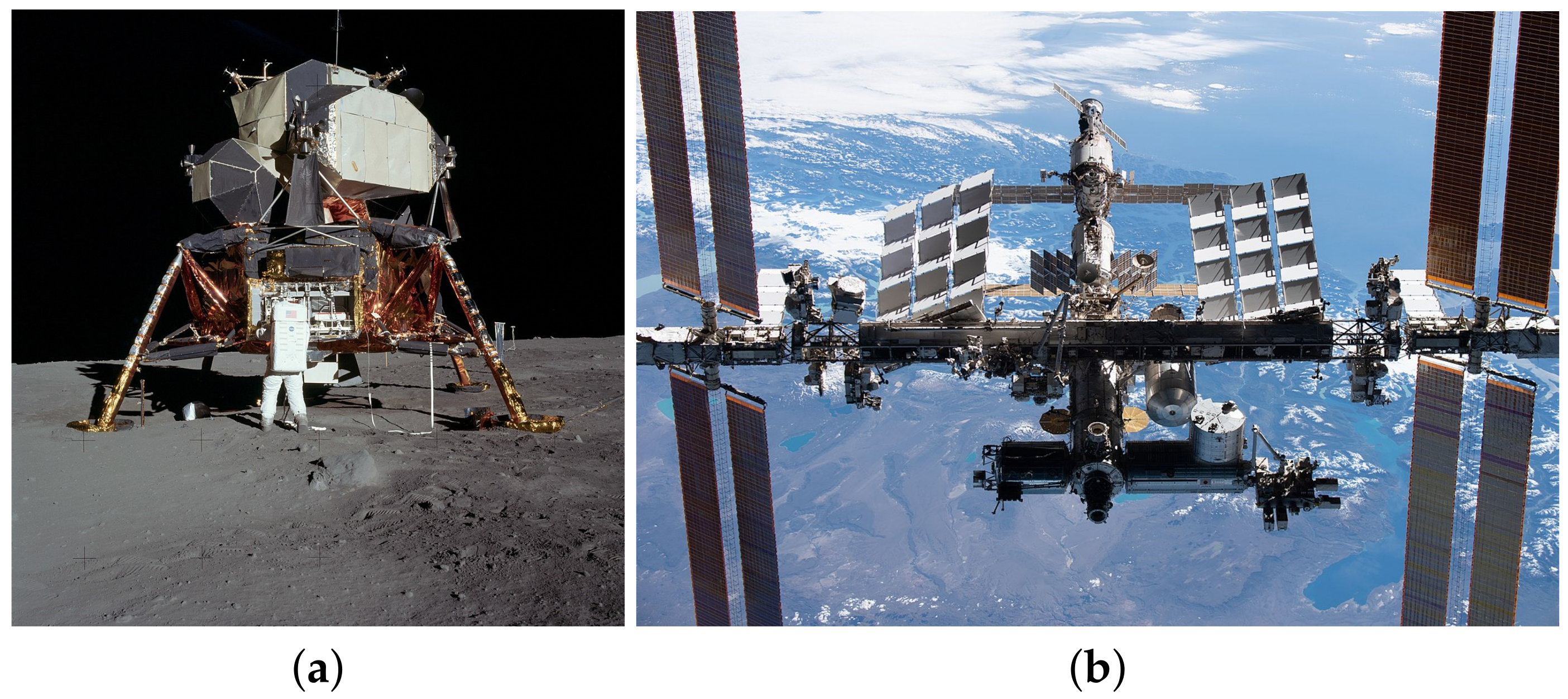
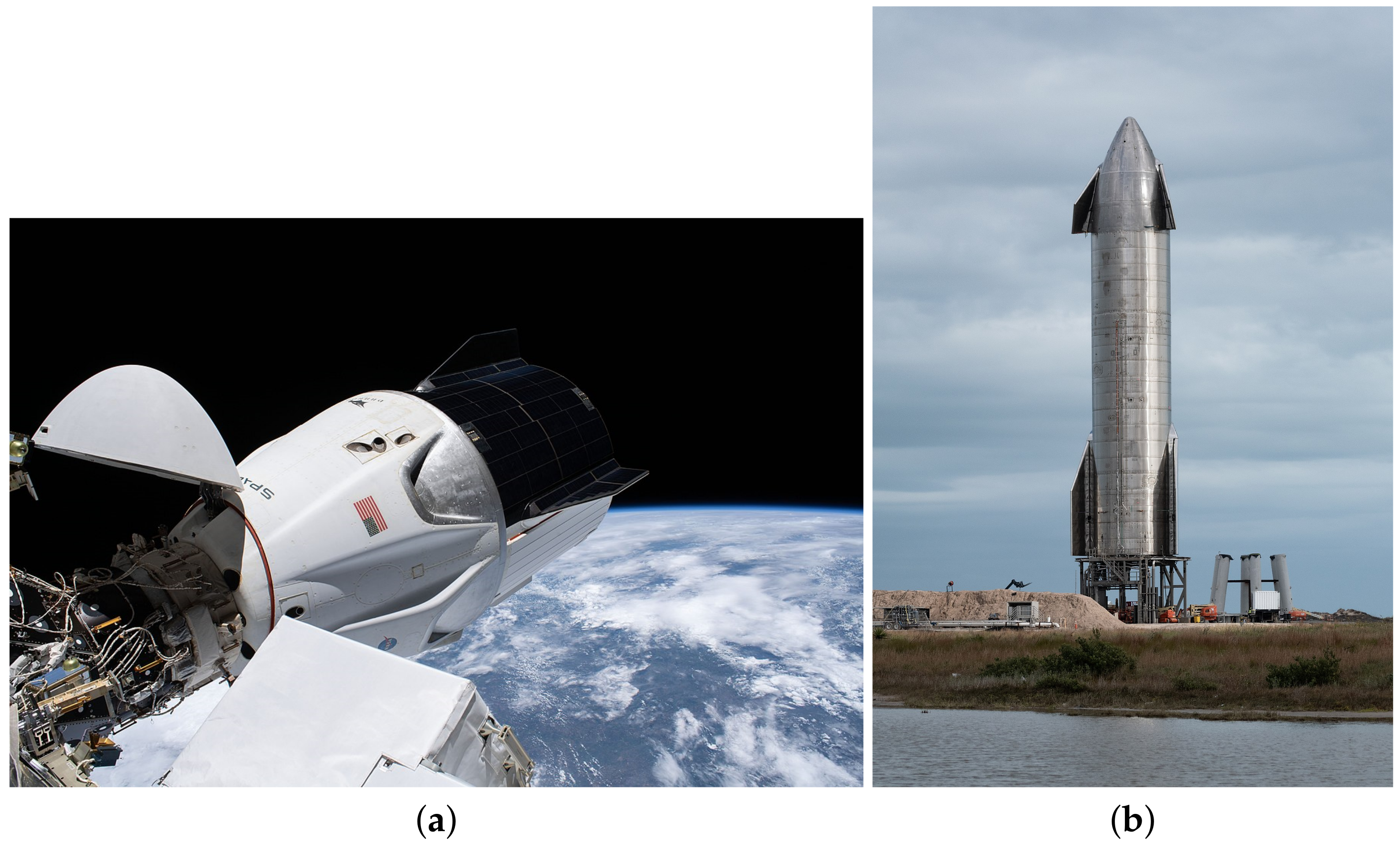
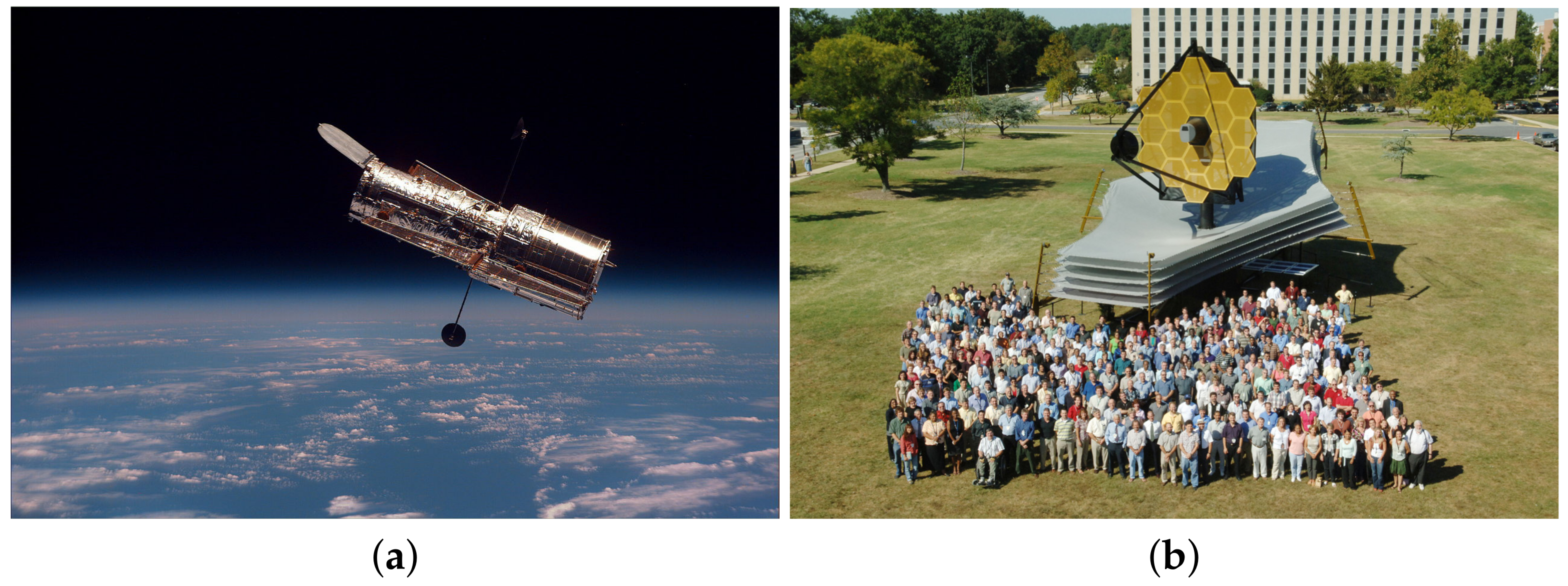
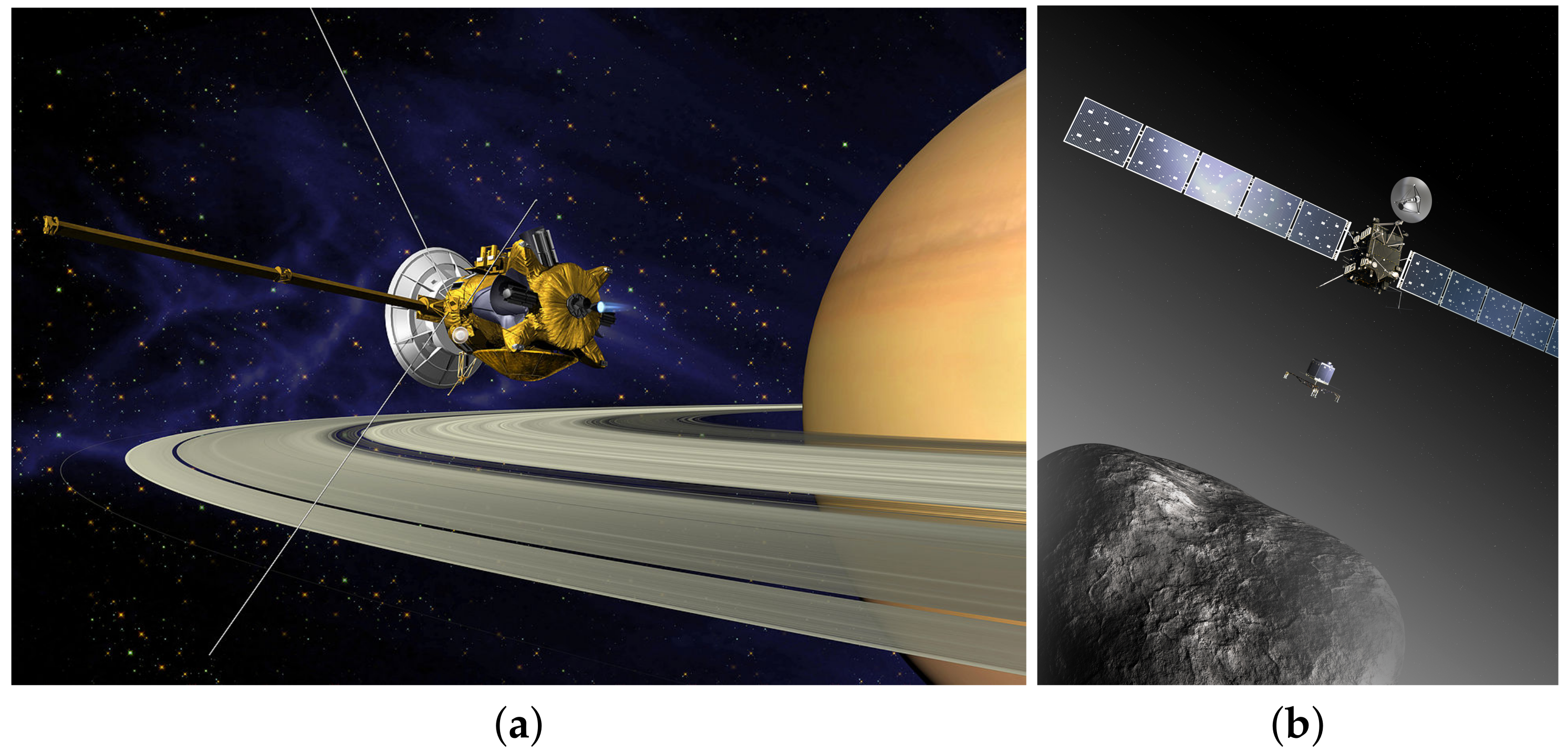

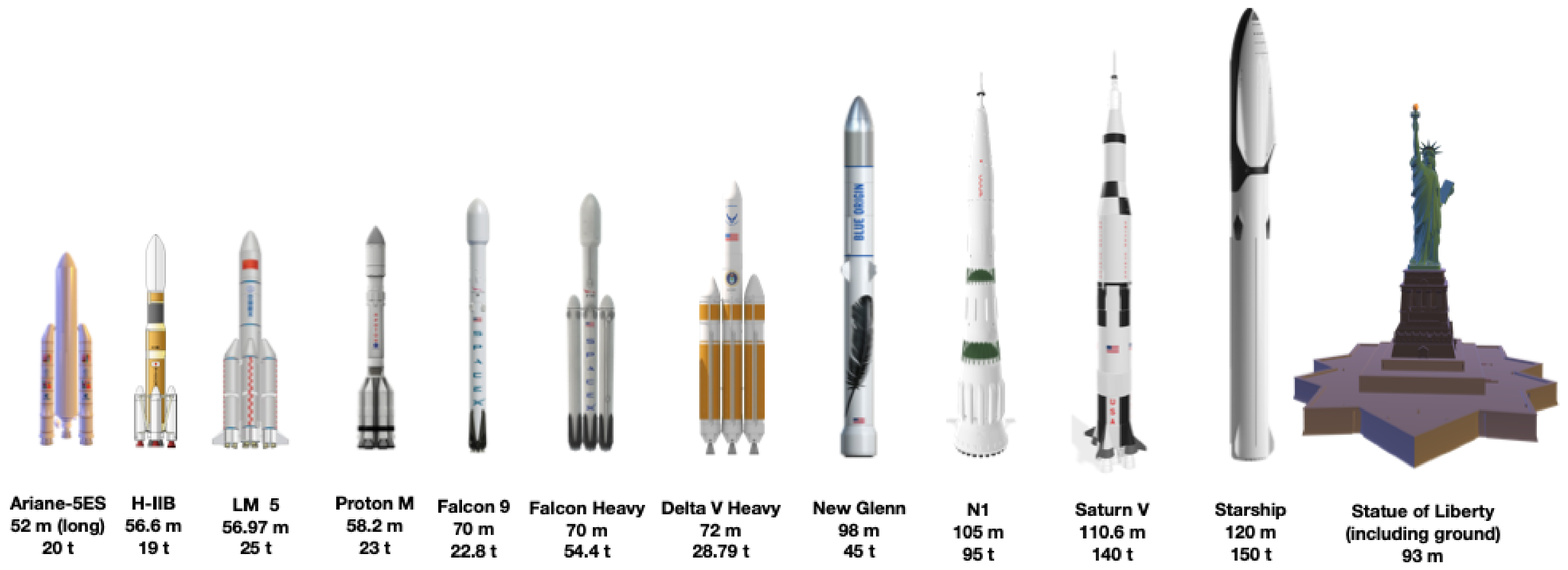
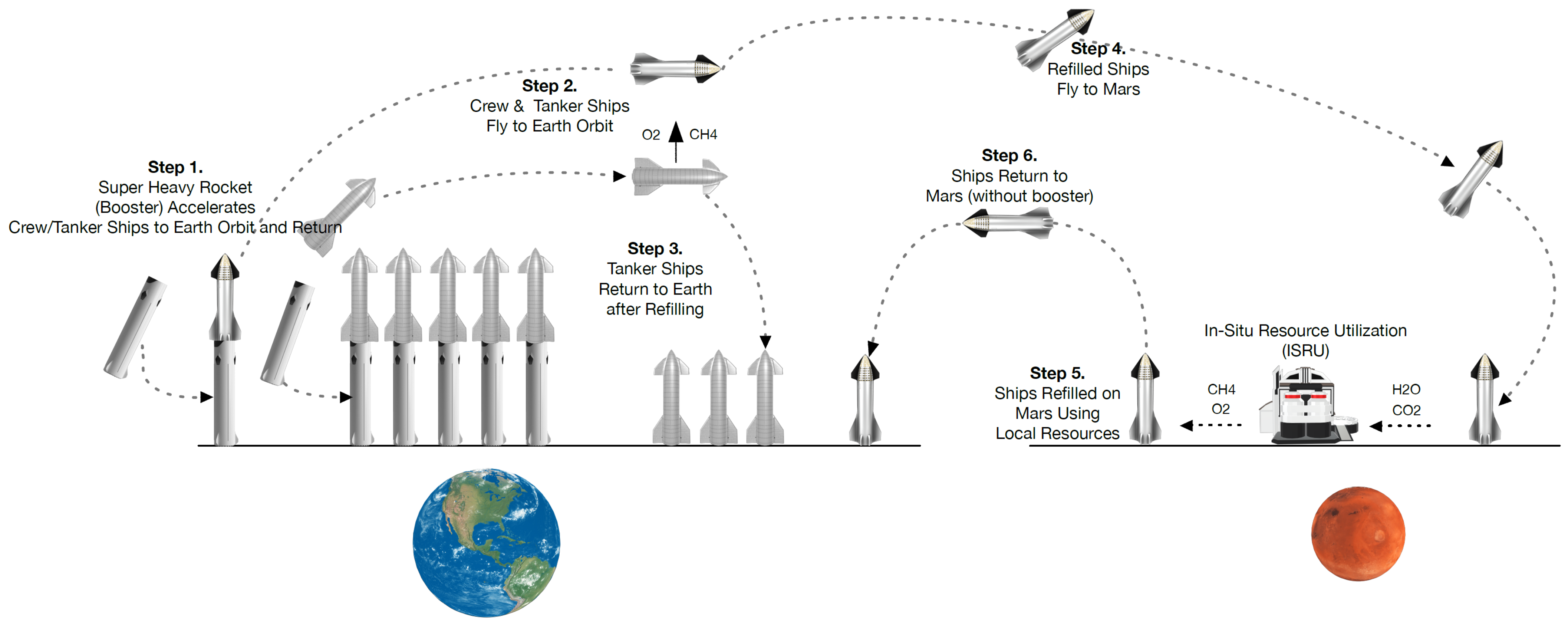
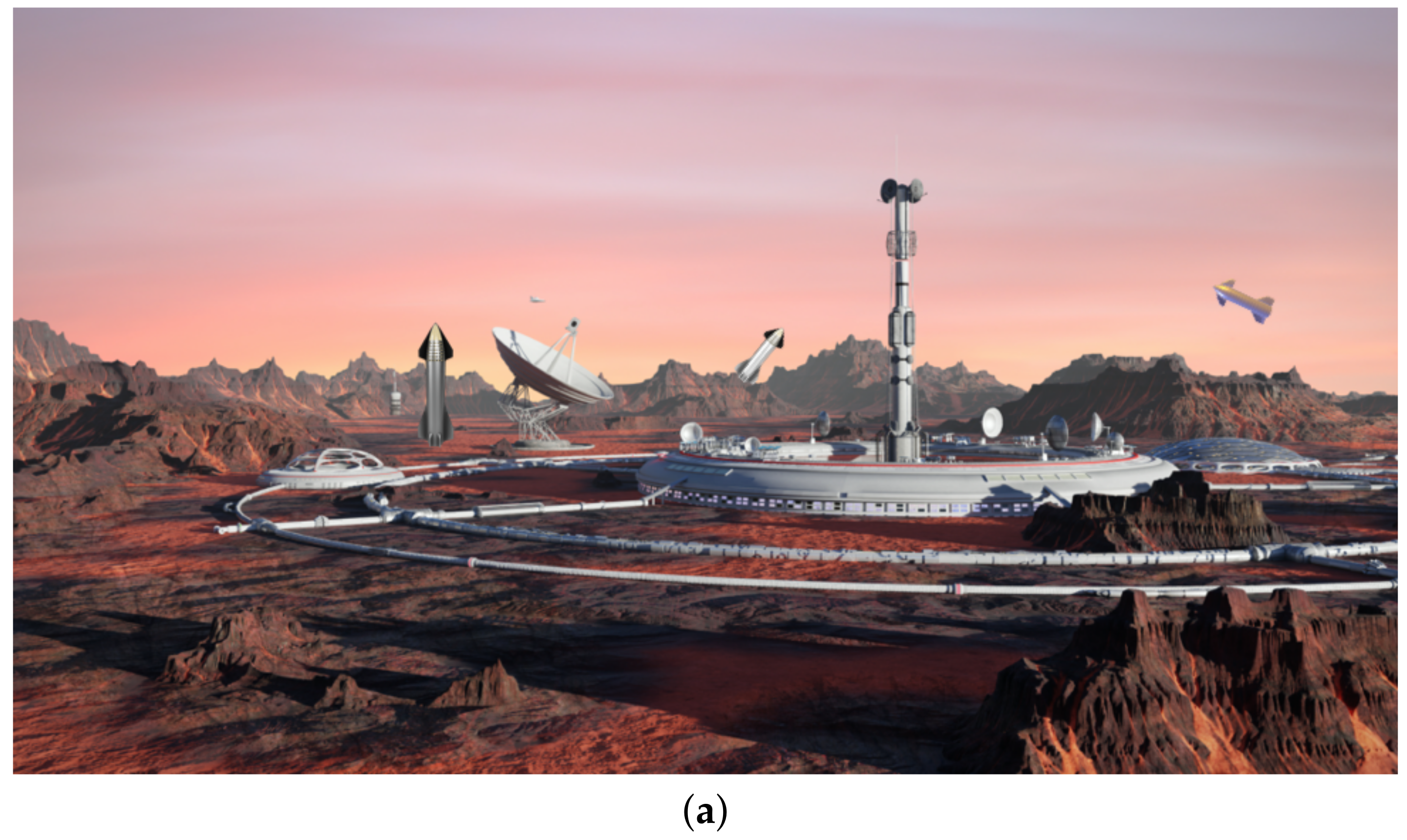
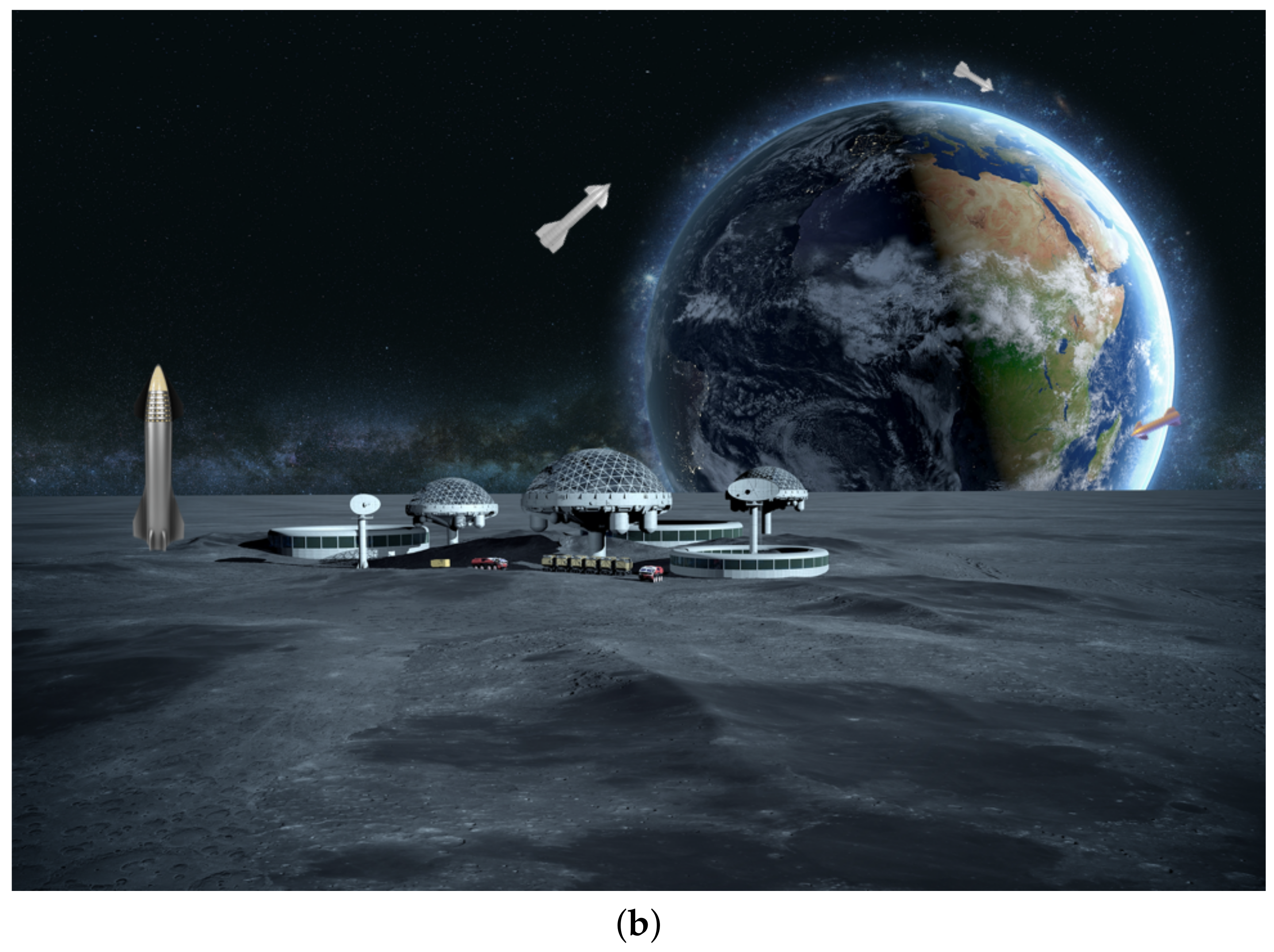

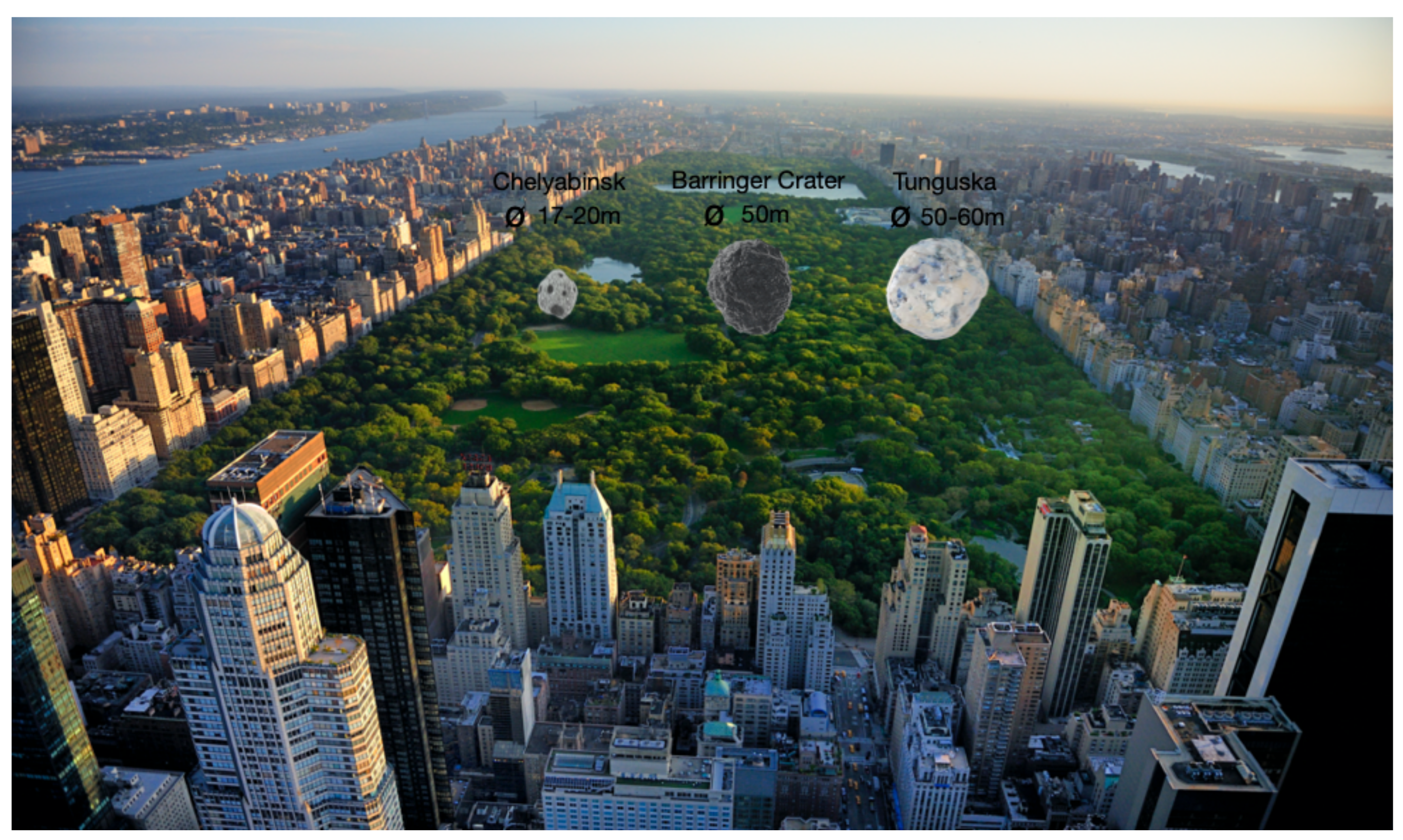
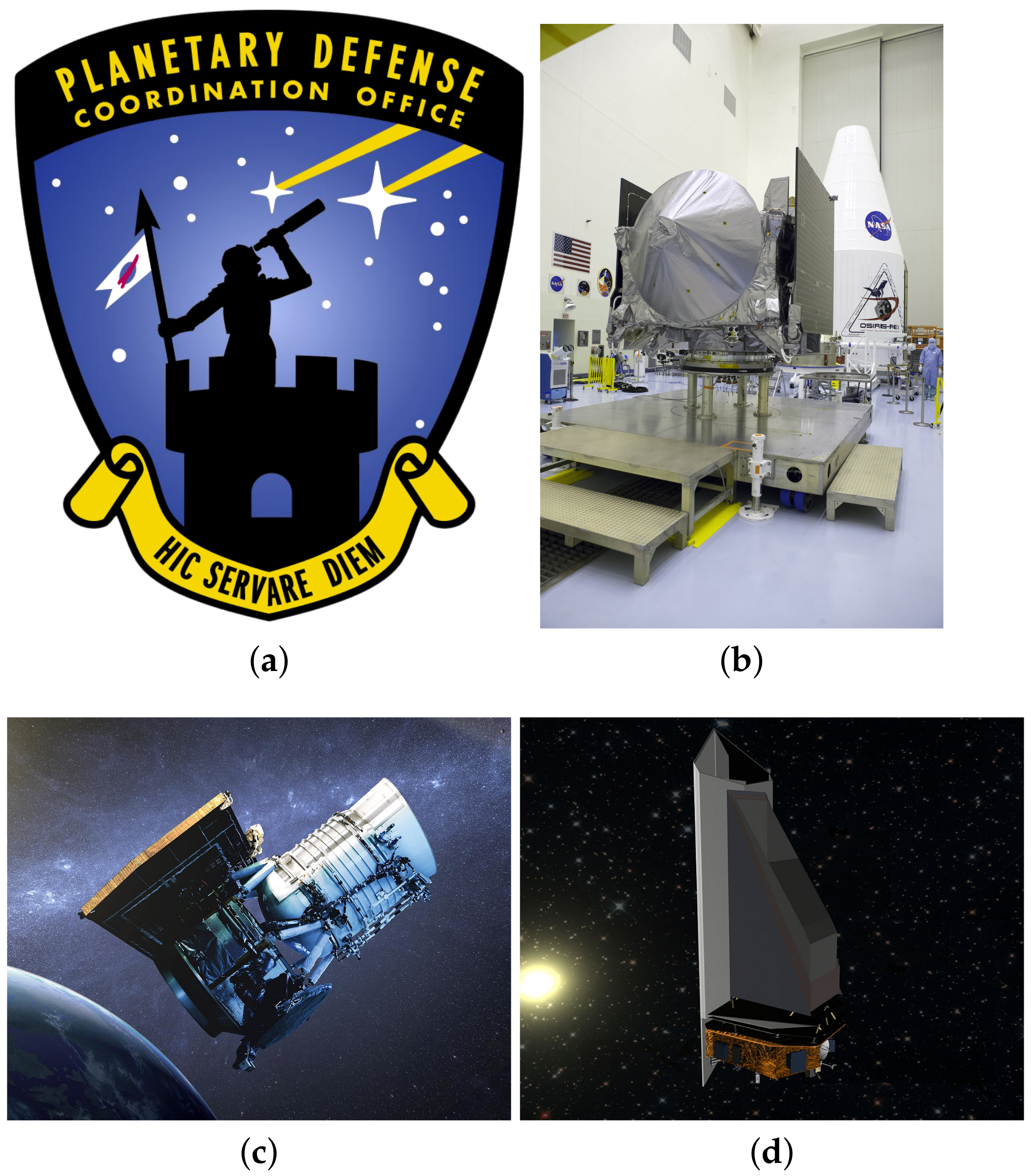
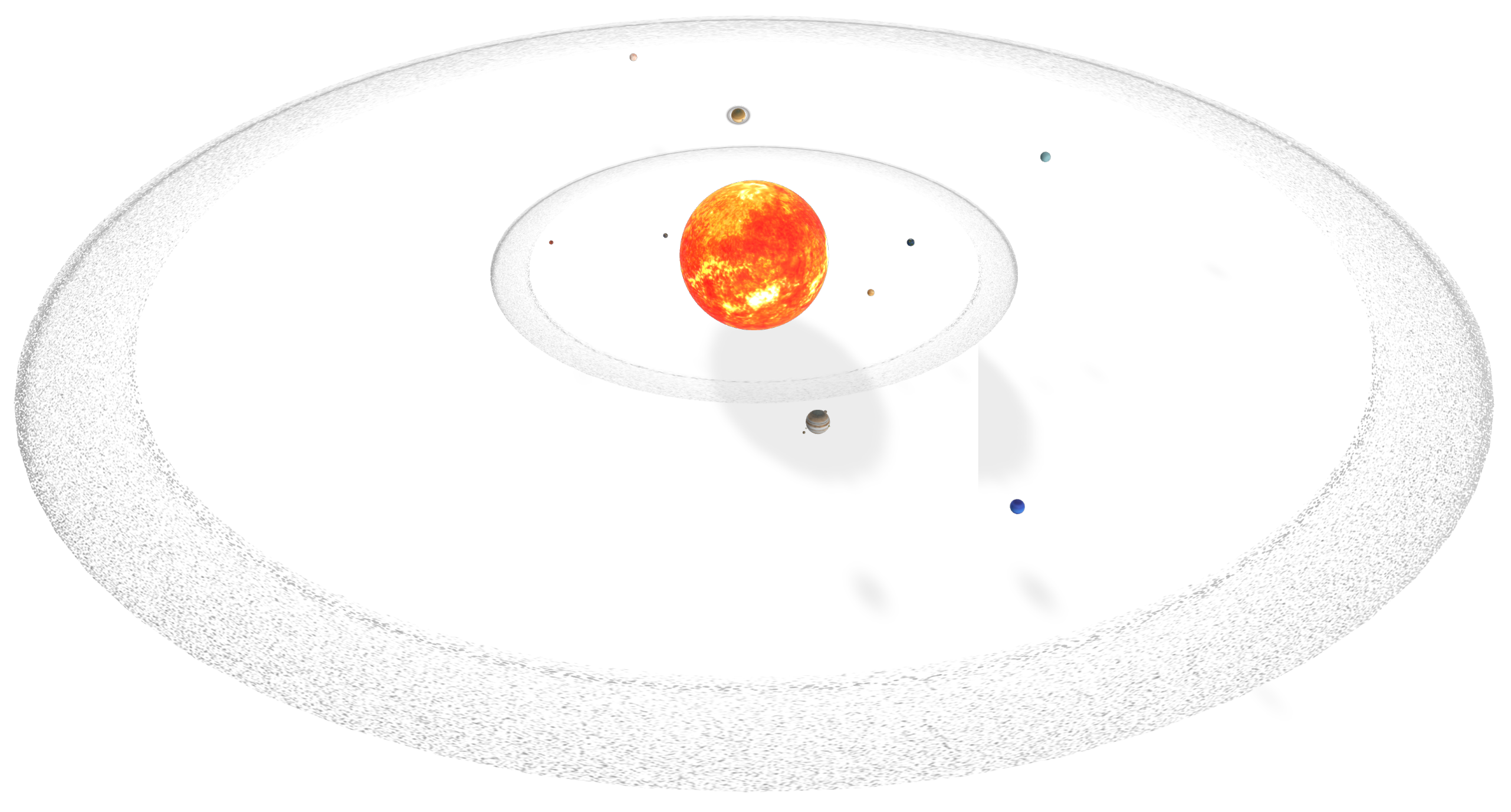
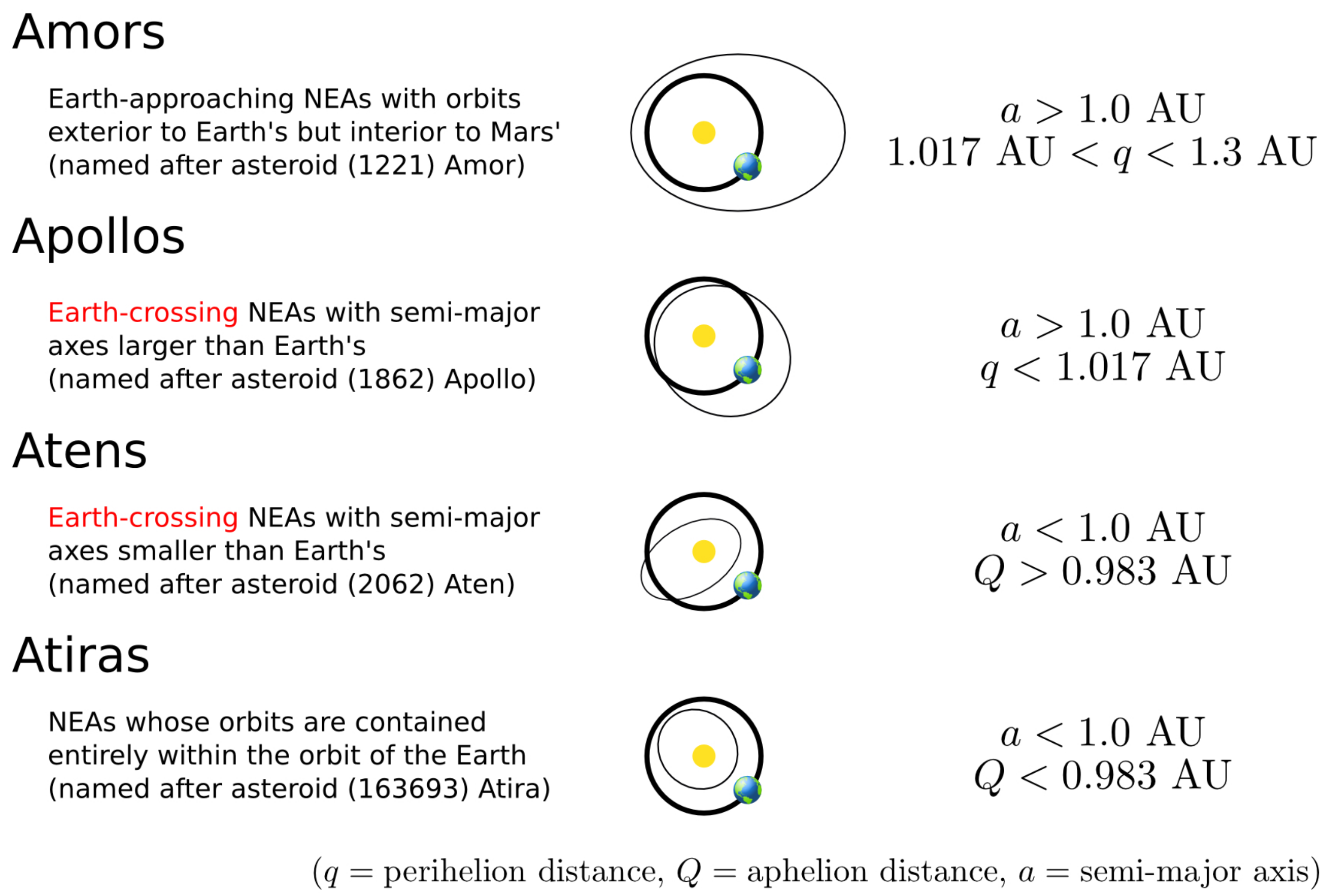
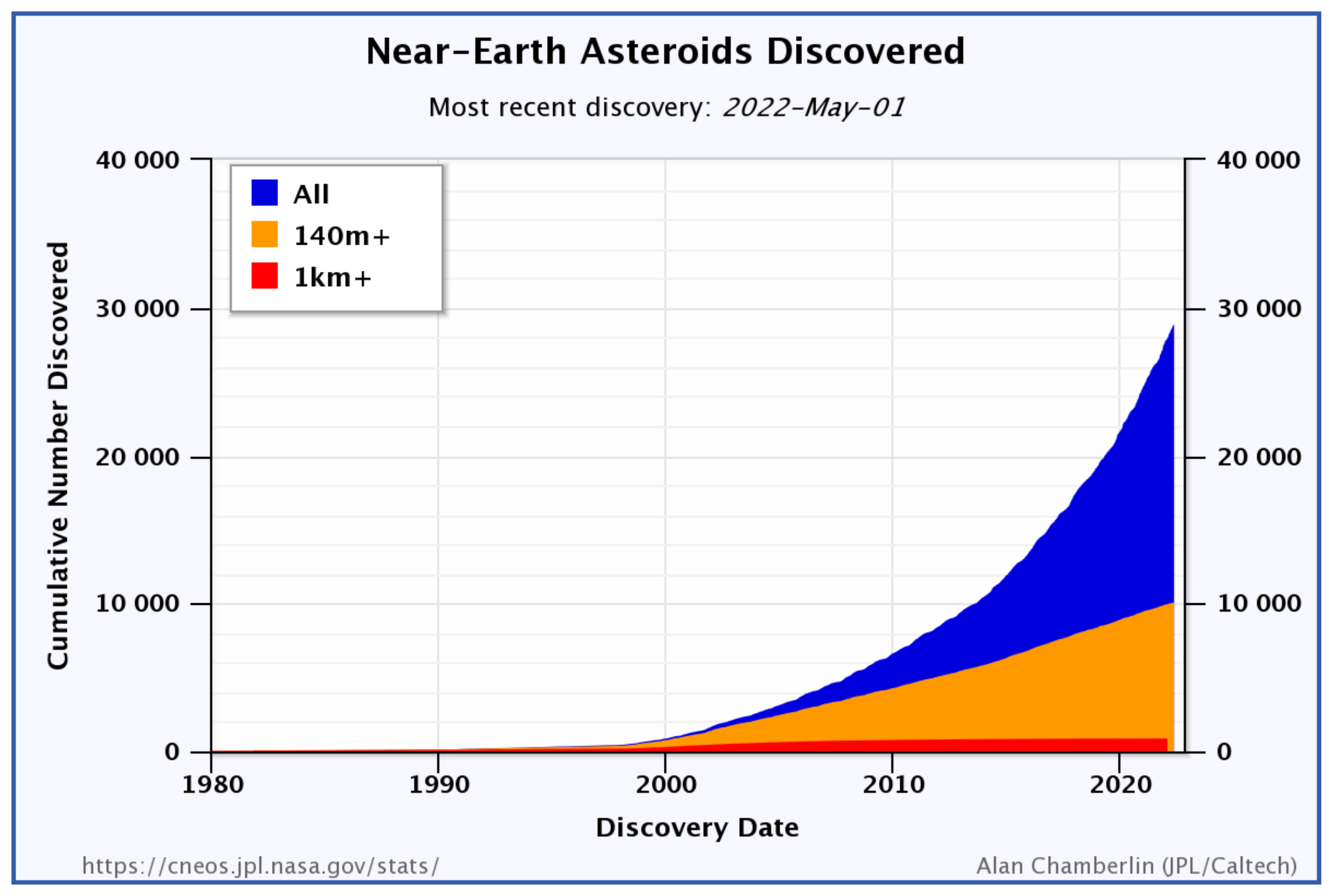
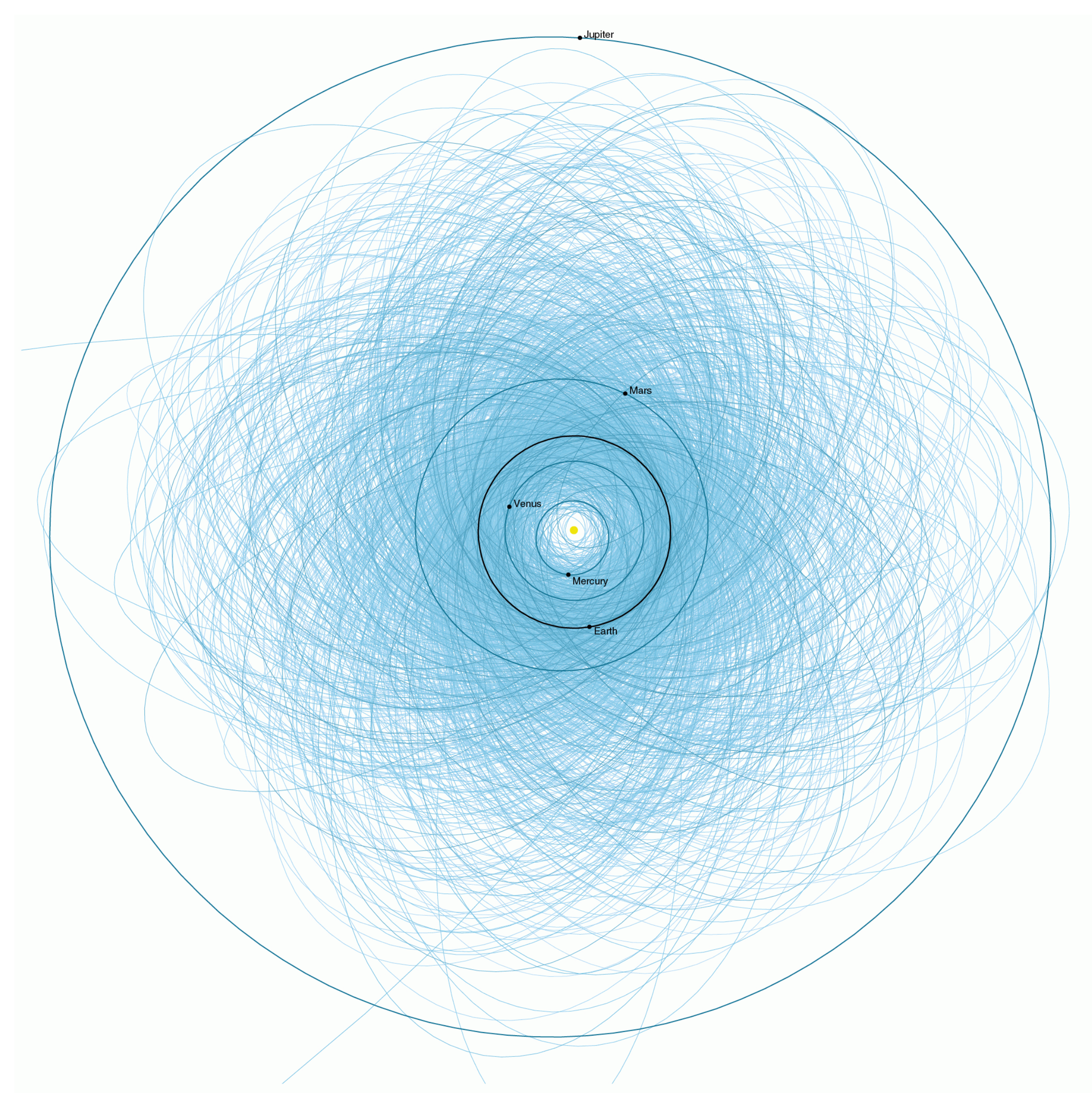

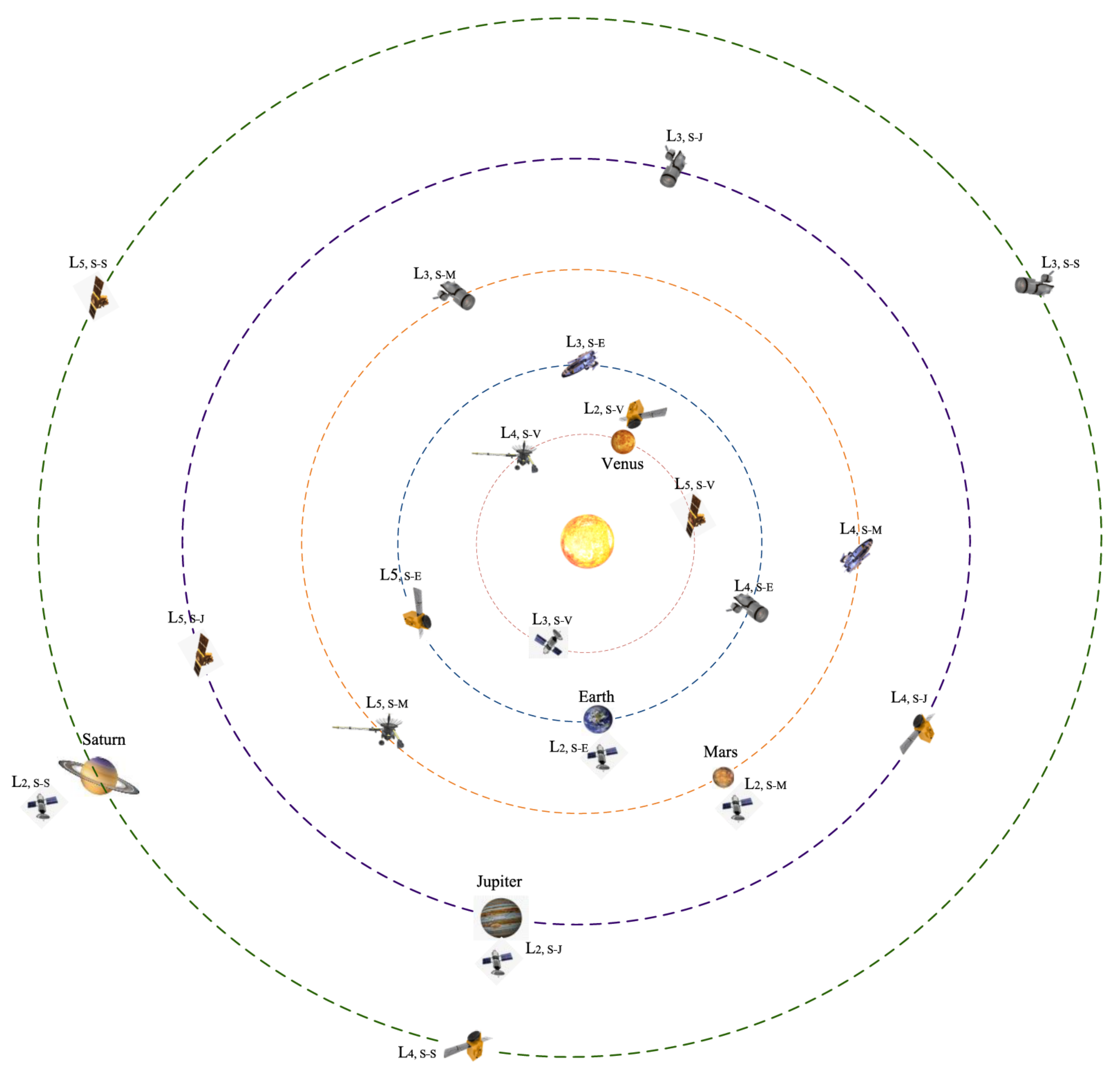
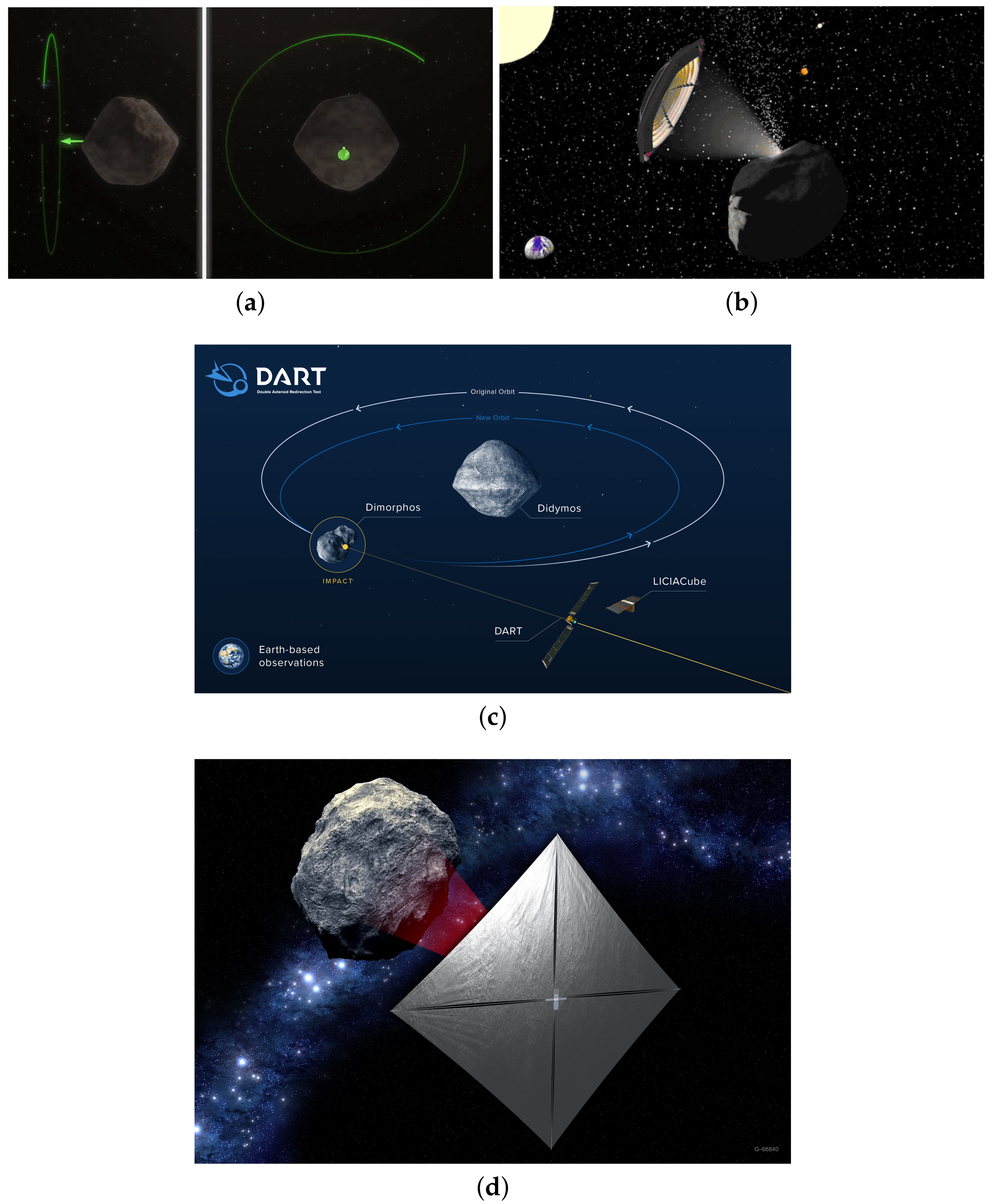


| Category | Type | Example | Launch Year | Program Entity | Status | Feature |
|---|---|---|---|---|---|---|
| Vostok 1 | 1961 | USSR | retired | world’s first | ||
| Freedom 7 | 1961 | USA | retired | reached 187 km | ||
| Apollo 11 [1] | 1969 | USA | retired | world’s first crewed moon landing; command and service module and lunar module | ||
| spacecraft | Shenzhou 5 | 2003 | China | retired | China’s first | |
| Crew Dragon Resilience [2] | 2020 | USA (SpaceX) | ISS transportation mission finished | world’s first crewed spaceflight operated by a commercial entity; reusable spacecraft | ||
| Virgin Galactic Unity 22 | 2021 | USA (Virgin Galactic) | continued | air-launched suborbital spaceplane for tourism; Mach 3.2 by rocket engine; reached 86.1 km | ||
| New Shepard 4 | 2021 | USA (Blue Origin) | continued | suborbital, reached 107.05 km; first flight with owner; reusable spacecraft | ||
| Crewed | space shuttle | Columbia | 1981 | USA | retired | reusable 23-ton payload |
| Salyut | 1971 | USSR | deorbited | world’s first | ||
| Skylab | 1973 | USA | deorbited | 360 m, 2249 days | ||
| Mir | 1986 | USSR/Russia | deorbited | 350 m, 5511 days | ||
| space station | International Space Station (ISS) [3] | 1998 | USA/Russia/ ESA */ Canada/Japan | orbiting | 915.6 m, largest area; longest service | |
| Tiangong-1 | 2011 | China | deorbited | China’s first prototype | ||
| Tiangong | 2021 | China | orbiting | a space of 110 m | ||
| Sputnik 1 | 1957 | USSR | deorbited | world’s first artificial satellite | ||
| Earth-orbit satellite | Hubble Space Telescope (HST) [4] | 1990 | USA | orbiting | numerous scientific findings including research leading to Nobel Prizes | |
| Starlink | 2019 | USA (SpaceX) | orbiting | largest satellite constellation for broadband access | ||
| lunar probe | Luna 1 | 1959 | USSR | finished | world’s first flyby | |
| solar probe | Parker Solar Probe | 2018 | USA | continued | the first to enter the solar atmosphere | |
| Mariner 4 | 1964 | USA | finished | world’s first flyby | ||
| Uncrewed | Mars probe | Perseverance | 2020 | USA | continued | Ingenuity, the first Mars robotic helicopter |
| Voyager 1 | 1977 | USA | traveling | first flybys of Jupiter, Saturn and Titan; Furthest and first interstellar spacecraft | ||
| planetary probe | Cassini- Huygens [5] | 1997 | USA/ESA/ Italy | finished | first Saturn orbiter and moons flybys; Huygens probe landed on Titan, first (non- Earth) moon landing | |
| New Horizons | 2006 | USA | continued | first Pluto flyby | ||
| comet probe | Rosetta [6] | 2004 | ESA | deorbited | first comet landing | |
| planetary defense | Double Asteroid Redirection Test (DART) [7] | 2021 | USA/ESA/ Italy/Japan | traveling | first kind for testing a method against near- Earth objects (NEO) |
| Energy Source | Approach | Strategy | Key Technology and Features | Example | Comments |
|---|---|---|---|---|---|
| Stand-off approach | Interception and trajectory- changing | Denotation at 20-m or greater stand-off height; 10–100 times more effective than the non-nuclear alternatives | Project Icarus MIT Students [88]; NASA’s asteroid Interceptor “Cradle spacecraft” in [159] | In [88], a number of modified Satrun V rockets and creation of nuclear explosive devices in the 100- megaton energy range; In [159], the conceptual spacecraft contains six B83 physics packages with each set for 1.2- megaton yield and and to be detonated over a 100-m height. | |
| Nuclear Explosive Device | Surface and subsurface | Interception and trajectory- changing | Creation of a conceptual Hypervelocity Asteroid Intercept Vehicle (HAIV), which combines a kinetic impactor to create an initial crater for a follow-up subsurface nuclear detonation within that initial crater | HAIV can cope with 50–500-m diameter objects when the time to Earth impact is less than one year [160]; With a warning time of 30 days, a 300-m wide asteroid can be neutralized by a single HAIV with less than 0.1% of the PHO’s mass [161] | HAIV can generate high degree of efficiency in the conversion of the nuclear energy that is released in the detonation into propulsion energy to the asteroid; It may run an increased risk of fracturing the target NEO. |
| Comet Deflection | Interception and vaporize or trajectory- changing | One-gigaton nuclear explosive device weighting 25–30 tons, lifted on super- heavy rocket | Dr. Edward Teller proposed in 1995 Planetary Defense workshop [162] | Instantly vaporize a 1-km asteroid or divert a 10-km one; It can cope with short- period comets escaping from the Kuiper belt. | |
| Kinetic Impact | Kinetic impactor deflection | Interception and trajectory- changing | Sending spacecraft to a collision course to knock off the asteroid | NEOShield-2 mission from ESA [163]; Asteroid Impact and Deflection Assessment (AIDA) missions of ESA/ NASA, DART launched in November 2021 [7,164] | The DART impact will occur in October 2022 and allow Earth-based telescopes and planetary radar to observe the event. |
| Asteroid Gravity Tractor | Apply a small but constant thrust | Rendezvous with PHO and provide a small force | A massive unmanned spacecraft hovering over an asteroid to gravitationally pull the asteroid into a non-threatening orbit | Edward T. Lu and Stanley G. Love proposed [165] | The most expensive with the lowest technical readiness and many years to decades of duration might be required. |
| Focused Solar Energy | Focus solar energy onto PHO’s surface | Remote station and rendezvous | Construction of remote station with large concave mirrors, concentration is scalable | Proposed in [166]; Ring-array collector size is 0.5 PHO’s diameter [167] | In [167], 5000 times the sunlight concentration, 1000-N thrusting effect, forming gas flow. |
| Asteroid Laser Ablation | Focus laser onto PHO’s surface | Rendezvous and trajectory -changing | Concentrate laser energy to cause flash vaporization/ablation with reaction force | First proposed in [168]; Project DE-STAR, proposed [169] | Ref. [169] phased-array laser about 1 km squared, launched in increments assembled in space. |
| Ion Beam Shepherd | Pointing ion thruster at PHO’s surface | Interception and trajectory -changing | Use the momentum transmitted by a low- divergence (<15 deg) accelerated ion beam | First proposed in [170] | A 5-ton space debris can be deorbited in about 7 months with IBS mass less than 300 kg. |
Publisher’s Note: MDPI stays neutral with regard to jurisdictional claims in published maps and institutional affiliations. |
© 2022 by the author. Licensee MDPI, Basel, Switzerland. This article is an open access article distributed under the terms and conditions of the Creative Commons Attribution (CC BY) license (https://creativecommons.org/licenses/by/4.0/).
Share and Cite
Huo, Y. Internet of Spacecraft for Multi-Planetary Defense and Prosperity. Signals 2022, 3, 428-467. https://doi.org/10.3390/signals3030026
Huo Y. Internet of Spacecraft for Multi-Planetary Defense and Prosperity. Signals. 2022; 3(3):428-467. https://doi.org/10.3390/signals3030026
Chicago/Turabian StyleHuo, Yiming. 2022. "Internet of Spacecraft for Multi-Planetary Defense and Prosperity" Signals 3, no. 3: 428-467. https://doi.org/10.3390/signals3030026
APA StyleHuo, Y. (2022). Internet of Spacecraft for Multi-Planetary Defense and Prosperity. Signals, 3(3), 428-467. https://doi.org/10.3390/signals3030026






